Skyrealms of Jorune by Hulk Smash!
Intro
Original SA post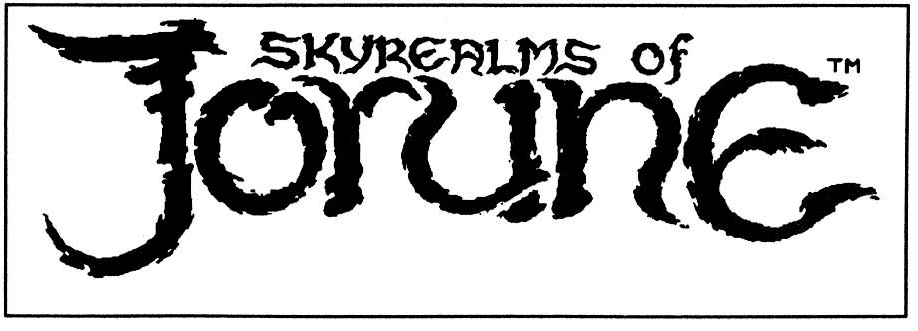
Intro
Years and years ago my cousin left me a boxfull of roleplaying books and a few box sets. Some of it I've read and used, others not so much.
Please join me for a read-through of Skyrealms of Jorune .
I will be going in blind on this one having never played or even read it (so please chime in if you know it and I miss something) but, from what I can gather from Wikipedia, it certainly seems to fit both the obscure and mockable criteria of the OP.
SOME BACKGROUND
Wikipedia tells me that the box set that I have is the 1st edition of the game and that it was published in 1985, It was written by some guy named Andrew Leker and illustrated by Miles Teves who, among other things, was a conceptual artist on Legend, RoboCop, Terminator 3, and Batman and Robin. I guess we can at least expect some quality and/or professional artwork.
What's in the box?
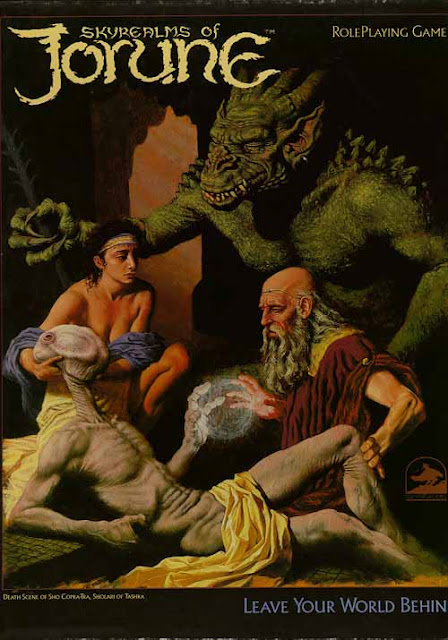
Box set cover art. The caption reads “Death Scene of Sho Copra-Tra, Sholari of Tashka” and the cutoff text should read “Leave Your World Behind”. Will do.
The box contains 4 books: A Player Manual, A Sholari Guide, something called a Tauther Guide and what looks like an adventure “The Skyrealm of Kolovisondra”. I'm not sure what a Sholari and a Tauther are so I'll play it safe and start with the Player Manual.
The Player Manual Chapter 1: Introduction
The book starts with the standard “what is a roleplaying game” speech and says that, as a player, everything I need to know to play is in the player manual and that only the referee should read the Sholari Guide. In fact it refers to the GM/Referee as “Sholari”. I still don't know what a “Tauther” is though.
It then gives a brief overview of each chapter which we'll cover in details as I read them.
Plot Synopsis
Ok, so, in 2116 interstellar travel becomes a reality. We can now travel at FTL speeds. Using this new technology Earth scientists from several nations started a search for habitable planets in other solar systems. IN 2123 an umanned probe detected a life-supporting planet.
The probe reported a lush planet with a fully developed ecology an many forms of life. The planet was named “Jorune”.
Explorers (I guess they're doing manned missions at this point, it doesn't say) discovered a race of intelligent being on the planet called “Shantas”. Tall, thin-limbed humanoids that communicate via a language combining pictograms, phonics and colors. It was months before computers could translate the language.
They also found minerals with “a very high energy density” that led to unusual geological formations. The energy from the minerals also formed a field across the planet. This field was stable relative to geography and had slight variations with the weather. It was deemed harmless even if unlike anything found on Earth.
Based on all that Earth decided that it would be safe to establish a formal colony on Jorune. The Shantas didn't stop colonization but relegated which lands the humans could occupy.
By 2155 all the 80 colony ships had landed and security was relaxed to make life easier on the colonist. The same year the colonies learned of a catastrophic war on Earth. The supply ships they were expecting would never arrive.
Ignoring the Shanta's restrictions, the colonist began clearing the land of native plant-life and to mine in forbidden areas. The Shantas were not amused but the humans ignored them since they had not seen Shantas use any form of tech capable of being a danger. Intervening Shantas were dealt with abusively.
Soon after mined ore from forbidden areas was being refined, the colonies were attacked by energies of almost nuclear proportion. Thousands were killed. Colony shields had offered no protection.
Desperately, one of the colony sites released a biological weapon designed to target Shantas. Over 99% of Shantas died, leaving only thousands out of a populous race.
Communication between colony sites was gone, survivors had no knowledge of other sites. At this point a bio-tech engineer called “Iscin” feared that no Earth animals (I guess the colonists brought them) would survive and modified them to make them more competitive with the native lifeforms. He altered several species into intelligent, bipedal creatures (… great). These species eventually developed stable populations.
The colonists fled to the jungles as there was apparently no hope of sustaining the colonies anymore (even though they clearly still had the means to create bio weapons and furries). Man became a hunter again.
It then jumps 3500 years later...
Humans have by that time grown to be one of the most populous species on Jorune and have developed two subspecies, Muadras and Boccords. After centuries of backsliding society is once again progressing. Earth is long forgotten and a distinct culture has emerged. Technological development has been impeded by the conditions on Jorune but humans have recently discovered caches of old Earth technology hidden by the colonists. They have learned to use these without fully understanding their principles.
The section concludes with “Life on Jorune is a paradoxical mix of old and new as the humans begin to comprehend their origins.”
So, yeah. Ok. We have classic science fantasy fare here with the added “bonus” of furries. Off to a good start!
Next time: Character Creation
Characteristics/Skills
Original SA post
The Player Manual Chapters 2 and 3: Rolling Characteristics and Skills
ROLLING CHARACTERISTICS
This chapter begins by telling us we'll need some dice (none were in the box but I'm not sure if that's by design or if they are simply missing after all this time). We're informed that we'll need d20, d100, d6 and d3.
We're then told that beginning characters are about 20 years old at the start of the game and headed in the direction of Ardoth, capital of Burdoth (city and country I guess?) with the goal of becoming a “Tauther” which, it turns out, is an applicant for citizenship. We're assured that the Tauther Guide will provide more details when we read it.
The three races of humans are then briefly described as follow:
Humans
The direct descendants of the colonists stand at an average of 5'10” for males and are a power to be reckoned with as the finding of Earth-tec energy weapons gave them quite an edge. They are the only race capable of using such weapons due to acceptable fingerprints. It then says that if the combined forces of Muadra, Boccord, Bronth and Woffen had not allied against them, their domination might have continued.
Humans are ruled by someone called a “Dharsage” and a council of 10. It is apparently easier for humans to attain citizenship.
Boccord
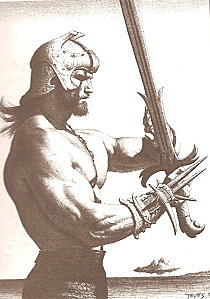
A Boccord. I had to scour the web for this, as quickly flipping through the book doesn't show one. Wait a minute. He looks familiar...
http://imgur.com/6ljWq
Oh, right. Ha!
Boccords are a human sub-species standing 7' tall that cannot use energy weapons. They are apparently sensitive to the patterns of energy radiated by all individuals and, at high levels of sophistication, can detect animals and people at great distance with it. They share the power with humans in Burdoth.
Muadra
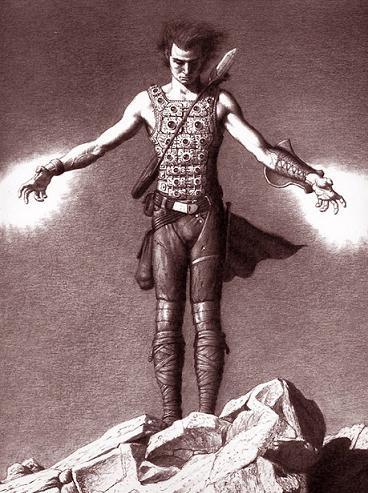
Again had to go to the web for that one.
Another human sub-species. They average 5'5” and can manipulate the Jorune energy. Muadra who devote themselves to energy manipulation are called Caji. PC's are to be beginning Caji. They share power with humans and Boccords in Burdoth.
CHARACTERISTICS
There are 10 attributes separated into 3 groups. Characteristics are generated using 3d6 per attribute and distributing a bonus d6 per group. The range is 3-18. The attributes are:
Learn: This one is not part of a group and is the only one rolled by using 1d6+7. It says that a PC may use a bonus dice from one of the group and apply it to learn instead but that it cannot go above 13. This attribute is a measure of how easy it will be to improve skills.
Group 1:
Constitution: general health and how much injury can be taken.
Social: “A running index of acceptance and status in Burdoth”. Its also background and wealth of the parents. The higher scores will have an easier time becoming citizens – which I'm beginning to think the game feels is a big deal.
Color: The character's ability to understand different facets of Jorune's energy. Muadras use it to make use of their energy talents while humans and Boccords use it to interfere with said talents.
Group 2:
Strength: Physical strength. Races also get a size modifier (-1 muadra, +1 boccord, 0 for humans) and a STR of 17+ gives a STR bonus of +1. Size and STR bonuses combine for the attack bonus.
Education: The more education the more skills the character will have to start with.
Isho: We're told that “Isho” is the Shanta's word for life, energy and vitality. For gaming purposes it's the amount a body can accumulate and use. Muadras add 20 to their score. Isho points are spent when using energy manipulation or “Dyshas” (I need a glossary).
Group 3:
Speed: Run in meters per round. Also speed in miles per hour. Speed of 17+ gives +1 to hand to hand.
Agility: Used mainly for melee combat. Bonuses at 13+ (+1) and 17+ (+2)
Aim: used mainly for ranged combat. Bonuses starting at 8 (+1) all the way to 24 (+5)
We then see a size comparison chart.

From L to R:
 x3, boccord, human, muadra, Shanta I guess,
x3, boccord, human, muadra, Shanta I guess,
 and
and

SKILLS
The chapter starts by telling us to multiply our Education attribute by 10. This will be the total amount of points we get to spend on skills and skill groups. It then says that the higher the difficulty of a skill, the more points it will cost. A difficulty zero skill costs 5 points per skill level while a difficulty 4 skill costs 25. Makes sense so far.
Skills also have “skill levels” and a beginning PC can only have skills at level 5 max when starting out. We can also buy skill groups which are a bunch of different skills in one neat package with a set cost.

An example of a skill group. “Bureaucracy”
For example, in the image above we can see that learning Writing is a difficulty 0 skill and that, if we had skill level 4 in it, we would have a 30% chance of success with a d100 roll under method. This would cost 20 points of education (4 (skill level) x 5 (skill difficulty of 0)) to initially buy.
However we could also buy the Bureaucracy package for the cost of 20 EDU points. This would give clerical, writing and messenger at skill level 1. A saving of 10 points VS buying them individually.
So far so good but I really hate systems that give more skills (in this case points to buy them) based on a random roll.
I won't list all the skill groups that can be bought but examples are: entertainment, range combat and thief (what the game calls Githerin) skills.
IMPROVING SKILLS
When 5 education points are accrued for a skill, we get a chance to increase them. Education points are received through skill use. If a skill is used during the week, the game tells us, we get to put a check next to it. We then get to roll 3d6. If the result of the roll is under the Learn attribute, the skill gains an education point. When you have education 5 points in the skill, it goes up one skill level (i.e 4 to 5). Oh, and you subtract the skill's difficulty from your Learn attribute when rolling. So a difficulty 5 skill would reduce a Learn of 12 to 7.
If you roll 3 or 4 on your 3d6 you get the EDU point and get to try again for another one.
Every 6 months of game time the player gets 5 checks to use for skills that are infrequently used. The rules for improving those are the same. This is called “broadening your skills.”
SKILL DESCRIPTIONS
I've read through the skill list. I won't list them all as most are standard RPG fare but a few stand out.
Messenger : A success indicates that the parcel or message was delivered in a way that even the most demanding of supervisors would find nothing wrong with. Really? We need a skill for this? I'd get it if we'd be playing UPS the RPG or something but this seems like overkill. A running theme for skills it will turn out.
Clerical : How good are you really at filing paperwork an filling out forms? This skill will tell you! Seems lifted right out of Paranoia .
Under the hunter skills we have three skills dedicated to saving very specific animal parts. Save Crill Boc-Rod , Save Thailers and Save Grunder . From what the game says, it seems these animal parts are valuable and/or rare but seems to me that one skill for all three would save space – especially considering that all skills are listed as the bureaucracy image above on the character sheet. Oh, there's also a Tanning skill if what you want to save of the animal is the hide.
There's also a Sailing skill. This is used when you want to swab the deck, row an oar or other menial tasks on a ship. This is distinct from Sail Master (using the riggings), and Navigation (navigating the ship). I understand that in real life these are very different skillsets but, again, seems like overkill.
In the end the character sheet (which I forgot to mention is also included in the box) ends up being 4 pages printed on a folded 17 by 11 sheet. Skills take up most of the space due to the formatting.
Overall it looks like the skill system would work. It might not be the most elegant and the skill selection is a bit nitpicky but the basics are there to get the skill rolls going.
Perhaps the Sholari guide will expand on skill use but, again, I'm going in blind and reading in order.
Next time: Dyshas
Dyshas
Original SA post
The Player Manual Chapters 4: Dyshas
This section is where we'll learn of “Dyshas” which are the use of energy in constructive forms and the basic concepts of the Jorune energy. This is also where the design is not helping – lots of new terms to help, we're told right off the bat that some terms won't make sense until the combat chapter, and weird formatting in couple of instances.
Isho: Ambient Jorune Energy
We're told that this energy emanates from vast underground deposits of crystals and that this energy permeates everything on the planet. Many native life-forms can instinctively manipulate it and all can “see” it. The energy accumulates around objects and in life-forms, allowing those with “Tra-Sense” to see it. In fact, this is the way the eyeless Shantas (I guess those are ears in the picture below) are able to see.
Each individual's personality, life experience and knowledge of Dyshas forms a pattern that can be viewed by those trained in Tra-Sense. The more preoccupied with one matter or attuned to one type of Dysha, the more vibrant the color of this pattern.
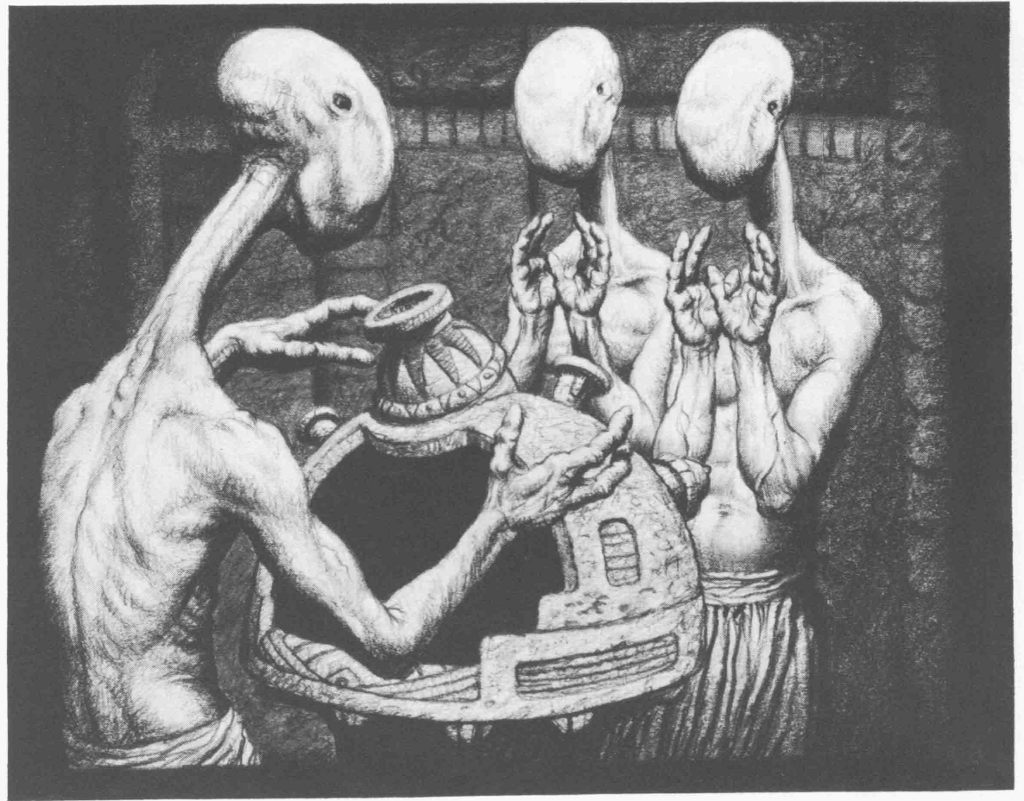
Shantas drying their hands using Shantic hand-dryer technology.
Muadra Skills and Perception
The human sub-species of Muadra have learned to manipulate the Jorune energy and “sculpt” it in the form of Dyshas. These Muadras are called Caji (learners). Those who gain mastery of Dyshas are called Copra. Each teaching is broken down in seven distinct category, each associated with its own color and one of Jorune's seven moons – Jorune has 7 moons it turns out. (Wouldn't seven moons cause crazy tidal patterns?).
Young Muadras learn to “Kern”. You see, this energy is constantly accumulated by the Muadras and will randomly discharge violently unless used. Kerning is the process by which untrained Muadras release that energy. This is done in special areas, strictly controlled, areas of most major cities. Once Dyshas are properly learned, kerning is no longer necessary.
The first step in learning Dyshas is to learn to cast a “Naull”. This is a soccer ball sized orb of energy that shows the colors known and personality of a Muadra. It's used as a sign of respect to show one's Naull to another Caji.
Next up Muadras learn the “quick release” of energy which allows them to project Dyshas away from their body. Useful when casting destructive Dyshas – you wouldn't want those to explode in your hand.
Caji Skills
As mentioned above, Dyshas come in seven colors/forms. Each form has a color points cost associated to them. To learn a form, one must spend the associated number of color points up to one's color attribute. They are presented below in the format of: color cost – Associated Moon/Form's name – color – Main attributes.
2 – Desti – Red – Bolts that inflict damage
3 – Du – Amber – Orbs of raw energy and heat
4 – Ebba – Yellow – Orbs of force to push
4 – Laudra – Green – Energy flowing about the body
4 – Gobey – Brown – Orbs which shield
5 – Shal – Blue – Complex orbs that affect the mind/body
5 – Tra – White – Space and Isho
So someone with a color attribute of 15 could learn Desti, Du, Gobey and Shal Dyshas for example (costs of 2, 3, 4 and 5). Only Dyshas from within a known form can be learned as skills.
FORMS OF DYSHAS
Dyshas come in three forms: Orbs, bolts and physical. Orbs are softball sized and are launched at targets. Bolts are also launched but are meter-long, lighting-like energy constructs, and physical Dyshas are trickles of energy along the body's surface.
PROFICIENCY WITH DYSHAS
Each Dysha known has a skill level ranging from 1 to 5. To successfully create (not hit a target, this comes later) a Dysha, the player has to roll equal or more to their Dysha's skill level on a d20. The rolls are 9 for skill level 1 and 1 for skill level 5. In essence, you will always succeed casting skill level 5 Dyshas.
CHOOSING DYSHAS FOR BEGINING CHARACTERS
Each Dysha also has a difficulty level from 0 to 3. Starting players can only choose Dyshas that are diff. Level 0 or 1. The cost, in Education points, to learn the Dyshas is 10 per diff. Level. So, a level 1 Dysha would cost 20 points to learn.
The game also mentions that starting characters will have a skill level of 1d3 for all their initial Dyshas. So a starting Muadra PC that chose the Du form and spent points to learn 3 difficulty level 0 Dyshas would then roll 1d3 for each to find his skill level with them. He might get really lucky and have all three at level 3 (roll above 5 on d20) or suck it up and have to roll 9+ on d20 for all three (skill level of 1).

USING DYSHAS
Each Dysha has an Isho point cost associated to it. This is the minimum that must be spent to cast it. You can also decide to double, or triple the cost to add effect to the Dysha. The effect depends on the type cast. For example you double the duration per factor spent above the minimum.
Each form/color group starts with a maximum of 10 Isho points that can be spent per round (2 seconds). Your Isho attribute is the total Isho that can be spent across all forms.
To find out the effect of a Dysha you roll 2d6 (+1 per factor of Isho spent above min – so +1 if the cost is 5 and you spent 10). You then either look to the description of the Dysha for the effect or, in the case of damage orbs/bolts, refer to the table here:
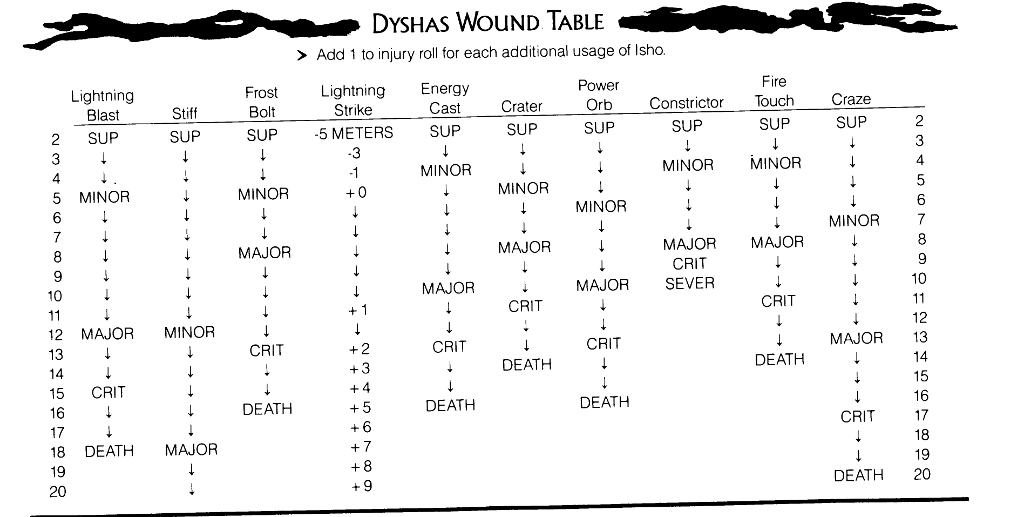
The Dysha injury table.
This is how damage is calculated in this system I guess. However, the combat chapter comes after this one so we may yet learn something else.
Dyshas also have a range which is based on the difficulty of each Dysha. Difficulty 0 has a range of 40 meters and difficulty 3 has a range of 10 meters. So more difficult Dyshas have a shorter range. Again, you could spend more Isho to increase the range.
CAJI DEVELOPMENT
Improving Dyshas works by gaining Education points (like skills). However, it only takes one Edu point to increase the skill level by 1. The catch is that the difficulty of the Dysha reduces your 3d6 roll by up to 15 points (for diff. Level 3 Dyshas). The penalty to the roll being 5x the difficulty level makes it hard to increase Dyshas but you get to try more often since you don't have to wait for 5 Edu points like for skills.
You need a total of 10 Edu points to learn a brand new Dysha (still within a form you know) at skill level 1.
If your 3d6 roll is 17+, you may not increase the Dysha until you train with a qualified teacher of that Dysha.
Also; you roll against Color, not Learn.
This all seems very restricitve BUT, you can increase your color attribute. How? Like this: “For every 2 Dyshas a Caji learns, that character's color rating increases by 1 point.”
The game then repeats the exact same phrase but in ALL CAPS. I guess repeating and yelling the point across is an effective method in the designer's mind.
You can also gain more Isho by expending at least half your total Isho at least 3 times during a game week. This will allow you to roll 3d6 (this time under your Learn attribute
 ). If successful, your total Isho goes up by 1 and the Isho maximum of the form you used during that week goes up by 2.
). If successful, your total Isho goes up by 1 and the Isho maximum of the form you used during that week goes up by 2.
Inherent Caji Skills
TRA SENSE
Only Muadra and Jorune life-forms have this. As previously stated, this allows you to “see” Isho around objects and people. How well you see is dependent on your color attribute. Color of 13 for example allows detection of things with 100+ Isho points within 10 meters. Color of 60 allows you to have a grasp of someone's basic personality. At 61+ (only Shantas have this) you know every details of someone personality, their thought process as well as the specific style of training they've received for Dyshas.
PICK UP WIND
You recover all your Isho points after a good nights sleep. However it is possible to recover them faster by “picking up the winds of Isho”. This will replenish your Isho to ½ maximum (so there's no point in doing it if you're above that already). It takes from 1 day to 5 minutes to do this depending on your color attribute.
CAJI ENTROPY
With this technique you can draw upon every shred of Isho resources your body possesses to temporarily increase your total Isho for 1 hour. First you need to pick for which form the Isho will be available and roll 3d6 a bunch of times until you roll sixes. The first time you roll a 6, nothing happens. The 2nd time you double your Isho, the 3rd time you triple it. Keep rolling until you've gotten 3 sixes. Each roll represents 10 minutes of concentration.
UNWEAVING
Caji can “unweave” incoming Dyshas thrown at them. To do so you must spend 1 point of Isho per 5 points received. Your maximum Isho in the form directed at you is the 5 chance of unweaving the bolt/orb before it strikes you. This cannot be done if surprised.
Humans and Boccord Energy Abilities
Humans and Boccord have adapted to the Isho winds as well. Although they can't cast Dyshas, they can both interfere with them.
Interfering is treated like any other skill (it's got difficulty levels and skill levels) and is a separate skill per form/color of Dysha. To interfere you must spend 1 point of Isho per 2 points received and roll under your interference skill for that Dyshas color. If you succeed, you reduce the damage roll by 2 points. This is instinctive and requires no preparation.
This skill is in high demand at high levels as it's the only safe way for teachers to train new Caji. They simply have the Caji throw Dyshas at them and critique the effects.
Humans and Boccord gain color at a rate of +1 point per game year. Boccords also gain a point of Isho when color increases.
Boccord Signature Abilities
Boccord have adapted to Isho in different ways than humans and Muadras. They have a % chance, based on their color attribute, to perfom the following:
SPOTTING
This allows a Boccord to sense the presence of creatures even when they can see normally.
SCANNING
By expending 3 Isho points, Boccords can scan for Isho signatures actively. Success indicates detection and another success rolls allows for identifying the type of creature it is.
FALSE SIGNATURE
By spending 5 Isho points the Boccord can create a fake signature to fool native Jorune life (they see only in Isho having no eyes). This can be useful to misdirect a predator or attract prey when hunting. The game mentions that Shantas are immune to this.
MASK SIGNATURE
When spending all their Isho, Boccords can become “Isho invisible” for one minute. Again, Shantas are immune.
The Dyshas
Once again we get a mention that Dyshas and their colors are based on Jorune's seven moons. I won't list all Dyshas but give an example per form.
DESTI: THE RED HARBRINGER
All Dyshas in this group are violent. Muadra who only know this group are seldom welcome anywhere in cities.
Lighting Strike : Strikes the victim causing damage and hurls them a few meters backwards.
DU: THE ILLUMINATOR
The amber light of Du transports energy in crude form like light or heat.
Orb of Light : Lasts for about an hour and will follow the caster, illuminating the area.
EBBA: THE SENDER
Yellow Ebba Dyshas either push or hold.
Levitate : Rise 3 meters per 10 seconds for 10 seconds (can increase duration by spending more Isho).
LAUNTRA: THE FLOW
Creates a slight green sheen on the body.
Quiet : Muffles all sounds given off by the Caji. Lasts 1 minute per 10 Isho spent.
GOBEY: THE PROTECTOR
Bubble : Creates a 3x3 meter stationary shield with a strength of 100 (we don't know what that means yet, I guess combat will tell us).
SHAL: THE KEEPER OF THE ANCIENT ORDER
The blue Dyshas of Shal affect the nervous system of living targets.
Drain : Drains ½ of the target's Isho points. They recover normally.
TRA: THE WARP MAKER
These Dyshas are concerned with the ebb and flow of Jorune's energy.
Create Warp : This will create a warp gate to a specific location. There's no way to know where the gate will open without a very rare warp map, the game tells us. The gate lasts for 10 seconds.
That's it for the Dysha chapter of the Player Manual. It works, I guess but I don't really like the fact that the system went from a d100 roll under for skills to d20 roll above for Dyshas. I see no real reasons at this point why it couldn't have used the same method for both with a little bit more design effort.
Next time: Building a Character
Combat
Original SA post
The Player Manual Chapter 6: Combat
We now come to the combat section of the rules. It looks like the combat is presented by core and optional rules. I'll list the optional rules in italic .
Combat is divided into three stages:
1) Roll for Advantage (initiative)
2) Roll for success for attack and defense
3) Resolve injury
The combat, like the Dyshas, uses a d20 roll above mechanic and 2d6 for damage.
Advantage
Every player rolls a d20 (modified by some factors that they present later) and consults a table. The table's results are:
1-5: No attack or defense possible.
6-10: Only defense possible.
11-15: Attack OR defend.
16-19: Attack AND defend in same round.
20+: Attack AND defend in same round, both at +5 bonus to your rolls.
25% of the time both parties will be in the 1-10 range and only be able to defend. When this happens, they circle each other or something and re-roll advantage.
When an attack is possible, the person with the highest advantage goes first (roll d6 to break ties). There's a bit of strategy here since if you can only attack or defend and so can your opponent. It might be wise to hold attacking to save the defensive action against the other guy's attack. Or you might attack and hope that you'll cripple him and won't have to defend.
Optional Rule: Advantage Modifiers: Here we're presented with example of situations that would modify advantage rolls. All are either +/- 5 or +/- 10 to roll. Examples include low visibility (-5 to all), defender is surprised (+5 to attacker), and Attacker behind defender (+10 to attacker).
Attack and Defense
Combat skills are represented on the character sheet as this image:
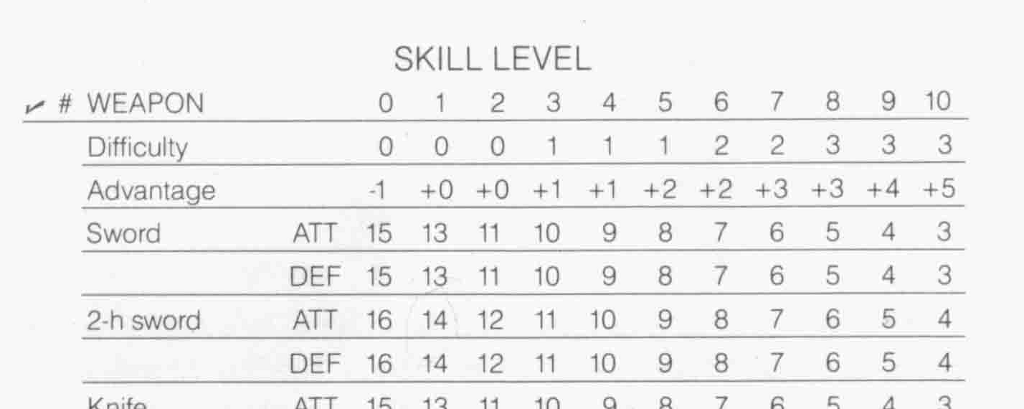
Combat Skills
Each weapon has a skill level from 0 to 10, a row of modifier to advantage, a row for attack and one for defense. So a PC with skill level 4 in Swords would get a bonus of +1 to his advantage roll when fighting with a sword, and he would have to roll above a 9 for both attack and defense. Some weapons (not seen on the image) have much better attack than defense or vice-versa.
For example, a morning star at skill level 3 has an attack roll of 7 and a defense roll of 16.
If the defender has a defense still available they get to roll for it using their equipped weapon. If successful, they parry the attack.
If you use a shield you roll for defense same as “defending with no weapons” but with a bonus of 2 to your roll. You can also defend on advantage rolls of 1-5 but carry an advantage penalty of -1 due to the shield's bulk.
Next step is to roll to see where you hit. This is a 2d6 roll. 2-3 = legs, 4-9 = body, 10-11 = arms and 12 = head.
Optional Rule: Special Attacks : You may choose to declare an attack as a Thrust, Lunge or Overhead Swing. Each has their own modifiers to armor penetration and damage rolls as well as modifiers to the attack roll. You also have to call which location you are striking. For example, choosing to Thrust at the body carries an attack penalty of 3 but will add +1 to your armor penetration roll.
Resolving Injury
First step is to roll for armor penetration (if the target has armor where struck). You roll 2d6 and add your attack bonus which is measured by STR and Size (from when we rolled attributes). Most humans have an attack bonus of 0.
You compare the result on a table which lists armor values VS weapon types. For example, leather armor has a value of 7 against swords but only 5 against a crossbow. If the 2d6 roll is above the armor value, damage is applied but at -1 to the damage roll. If the value is not beat, then no damage is taken.
Optional Rules: Wearing Armor : We're told that you can choose to reduce a person's advantage roll by -1 or -2 if they wear some types of heavy armor and/or their arms and legs are covered by armor.
The next step is to roll for injury. This is a 2d6 roll from which you subtract the size bonus of the target. Sample injury table below:
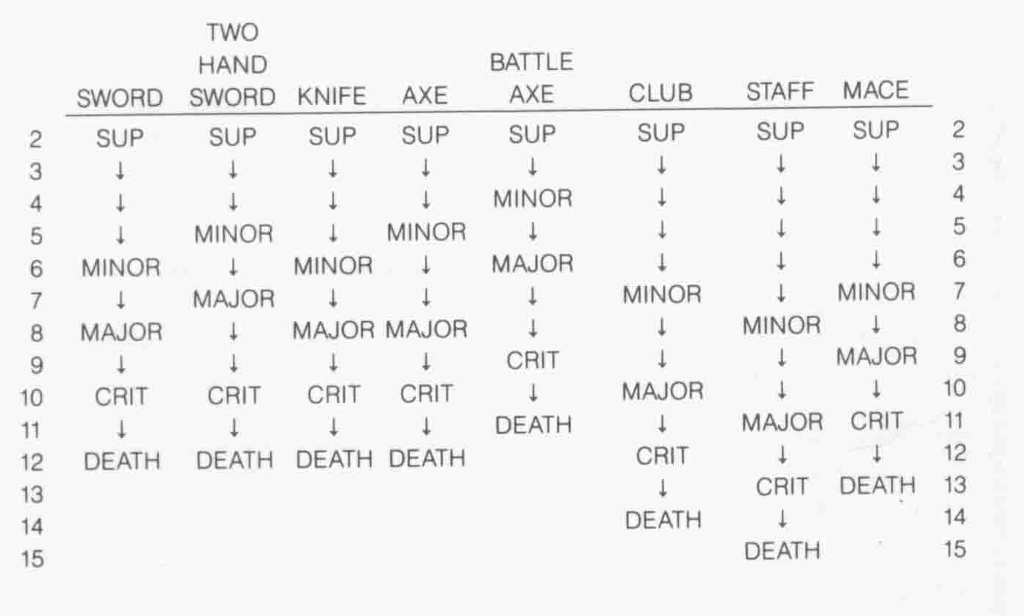
Weapon Injury Table 1
The possible results are then explained as follow:
Superficial wound: small bruises and cuts.
Minor wound: serious cuts and hard knocks.
Major wound: fractures and deep gashes.
Critical would: Immobile and will die without attention.
Death: limb is crushed or amputated, body dies.
The book then presents a table with injury results by location. SO you can look at it and see that a major wound to the arm, say, results in the defender dropping what he was holding in that arm and a -4 advantage penalty until treated.
Wounds are cumulative and you apply double the advantage penalties accrued against your Endurance. This is called the effect on Stamina. When your stamina reaches 0, you fall unconcious unless you roll 3d6 under your CON score. If you lose twice your CON value in stamina, you die from shock.
To give an idea, unless wounds are critical or death which basically put you out of the fight right away, the advantage penalties are -1, -2 or -4. So a fairly typical guy with a CON score of 12 could maybe take 1 major wound (-8 stamina) and one minor (-4 stamina) before falling.
It seems fairly deadly if somewhat mitigated by the fact that the attacker has to 1) succeed in his attack, 2) you must fail in your defense, 3) they must penetrate your armor and , 4) roll in the 7+ range on the injury roll to get to a major wound.
Optional Rule: Pulling a Swing : We're told that the attacker can decide the maximum level of wound he wishes to inflict before his action. So you could decide that you don't want to cause more than minor wounds. Any rolls above that would be reduced to a minor wound.
Optional Rule: The Force of Blows : Even if you fail to penetrate armor, still roll for injury. If the result would have been a minor wound the defender will have -5 advantage next round. If the result would have been major or higher, he falls to the ground/drops his weapon.
We then get rules for range combat (which are the combat rules used for Dyshas also). The rules are much the same except that defense is a doge and the roll to attack is calculated based on weapon type and range. So, for example, if you were to use a bow at skill level 5 within 50-100 meters of the target, you would have to roll above a 15 for 9 for a stationary target, a 13 for a moving target and a 18 for a running target.
You may also aim to improve your chances. Aiming adds +2 to your roll per round aimed. Each weapon type has a maximum number of effective aim. A bow would be 3 for a maximum aim bonus of +6.
Optional Rule: Movement in Combat : Here we find optional rules for the advance (close in on someone with a longer reach weapon) and withdraw (leave reach) which boils down to injury-less attacks and defenses to close in (i.e. successful attack closes-in reach). We also find rules for mounted combat (+5 to advantage for rider attacking foot target).
We then get advice for law and order (don't cause trouble in town) and morale (no one actually fights to the death unless compelled to) and incidental injury (big things fall on you or you fall from big things).
The chapter closes with a note on healing. It mentions that healing is a bit faster on Jorune due to the ambient energy and that some things can even make an arm grow back – things like crystals and something called “limilates”. There's no talk of resurrection though.
Basic healing is 2 points of stamina per wound per week. 1 point if you roll under END with 3d6 (again, per wound) and an automatic +1 stamina if all you do is bed rest.
The system works I guess but it has a whole lot of rolls per round which I don't particularly like. The advantage system seems like it could be interesting though.
Next time: More fluff about Jorune
Jorune/Sho-Caudal
Original SA post
The Player Manual Chapter 7: Jorune/Sho-Caudal
This chapter starts with a repeat of the timeline about the discovery and colonization of Jorune. It's almost word-for-word except for a few details.
Humans on Jorune
In this one we find that the planet was named Jorune after its discoverer “Kadija Rhen Jorune” (they'll have some weird names in 2123) and that small maned expeditions landed on Jorune a couple of years after its discovery. These early explorers found not only the Shantas but also the race of Thriddles. These Thriddles are the ones that allowed communication with the Shantas, having very quickly mastered English.
Unlike the Shantas, the Thriddles were very eager to interact with the humans and had much interest in Earth technology. While the Shantas were far more numerous than the Thriddles, neither was in a position of dominance. Other forms of intelligent life were also discovered, some of which lived in harsh terrain and climate for which they seemed very ill-suited. Communication with these species proved futile.
The presence of so many intelligent races was baffling to the Earth scientist. Their interactions were highly segregated and Shantas in particular had very little interest in any of them. On top of that most of the races lived simply and seemed uninterested in technological progress.
The Shantas, while highly intelligent, lived a peaceful race with little machinery but had impressive and elaborate underground architecture. Meanwhile the Thriddles lived in the ruins of a great past civilization – the architecture and scale provided ample evidence that it was not Thriddle-built.
The landing party then decided that larger colonization was feasible and the plans were put in motion. When learning of this the Thriddles were ecstatic but the Shantas reacted more coolly. They didn't stop the plans but relegated those lands that could be used.
Over 20,000 colonists arrived in suspended animation on 80 ships. Each was reasonably self-sufficient and had a large military presence. Supplies from Earth would be needed only every five years. Scientists were given great leeway in what they could bring and many Earth plants and species were brought along.
By the time the last ship had landed, the colonies learned of catastrophic war on Earth caused by Lunar mining rights disputes. The last communication they got from Earth indicated that Earth had lost all space-faring capabilities. A few days later communications were permanently lost.
The rest proceeds much like the intro backstory. We do learn that humans abandoned technology in the first 250 years following the war as it was believed that Shantas could detect it.
Shantas on Jorune
In parallel to this backstory we're also treated to the same events but from the point of view of the Shantas.
Shantas are the true natives of Jorune and had existed in relative peace for thousands of years before humans arrived. Although not totally passive their tech was centered more on life than death. For this reason they find the Muadras facination with destructive Dysha forms a mystery. For them Isho is more of a life force than a force of destruction – although they know all forms.
The Shantas had been living in their underground complexes when the “H-oomans” arrived. They spoke in an awkward lumpy tongue lacking clarity. Despite their apparent crudity the aliens skills in energy manipulation (Earth-tec) were impressive and were crafted of resistant “Tlesk” (metal). They also would insist on calling the planet “Jorune” and not it's proper name of “Sho-Caudal” (vast fluid body).
The H-oomans were unable to see or feel the natural flow of Sho-Caudal but the shantic Sholari (priests) encouraged cooperation to ensure peace and as little disturbance as possible.
Although Shantas understood the magnitude of 20,000 colonists they were taken aback by the bulk of colonists when they arrived. Their attempts at walking were shameful and their intellects seemed just as disorganized. It was even rumored that they could not control their bodily functions. Their inner fluids were pumped involotarily and their frontal lobes fluttered spasmodically. At first amusing their flat speech soon became to be considered a waste of time. The Thriddles came, as the Shantas knew they would, and they were delighted to speak unceasingly with the visitors.
The H-oomans inability to project even the simplest Naull orb was seen as a sign of dwarfed intelligence but they did command great Tlesk manipulation, so the Shantas were content to help them if it meant peace.
As the moons revolved the H-oomans relaxed and enjoyed their new environment. The new comers seemed to have proven their harmlessness, the treaties were respected.
The tranquility was suddenly shattered; the H-oomans began acting frantically. They claimed the loss of their homeland which the Shantas found strange as they had abandoned it on purpose. The aliens behavior became a concern and they became uneasy and fearful, which were new sensations to them.
Without warnign the H-oomans transgressed the treaties and started mining on “Cali-Shafra”, the battle land of the ancients. They stripped away vegetation, dug the ground for minerals and pierced the land with their Tlesk. When the H-oomans disrupted the Galsh-aca (ancient burial ground), the Shantas felt they had justification to unleash their energies.
The aliens were not prepared for the massive energy blasts that exploded from within their ships, bypassign the shields completely. For the Shantas it was a simple matter: the warp mappings were known and great warps were opened inside the ships while enormous Dyshas of Du and Desti were sent through them.
This was expected to be then end of it but, instead, almost all of the Shantas lapsed into “Shyee” (the Isholess state). The few who remained were unable to maintain the ancient undeground complexes. Society crumbled. The Shantas were forced to leave the glowing lower world for the more desolate parts of the planet.
Knowing that the H-oomans would eventually gain access to their cities, they laid to rest their valuables in temples and proceded to guard them as best they could. They looked to a time where their descendants would reclaim their heritage.
Over the centuries, Shantas have learned a bit about humans but their initial impressions have not yet been dispelled. 3400 years after the conflict, hostility between Shanta and humans is rare. The Shantas are waiting and watching for a chance to reclaim their ancestral splendor.
Of all the human descendants, Shantas find the Muadra the most intriguing. Their Isho ability is close to their own and this is what led Sho Copra-Tra (penis head from the cover) to teach Caji Gends (dwarf dude from the cover).
Shantic Technology
Shantic tech employs Isho as its power source. Many different instruments exist. Sarceens for example store information in the form of sculpted Isho. Cle-eshtas are small pillar-like stone constructions that allow a user to amplify a user's Tra-Sense. It is with this that Shantas were able to pinpoint energy weapons and track humans where ever they went.
Shantas can also employ warps for transportation. Every location on Jorune has a partner location to which it physically connects when energy is applied. A warp appears as a rectangular doorway that can be viewed from any angle. Two people standing slightly apart would have a different view of the other side. Walking around a warp gives a full 360 degree view. Although Shantas can't alter a warp's destination they can use their Cle-eshtas to find where one will open. This is how they sent Dyshas inside the colony ships. The mathematics to map warps are extremely complex and few besides Shantas can open them.
Shantic Sects
We find here that Shantas are divided into sects. Each sect is based around one of the moons and each have different attitudes. Members of the Desti sect for example are more belligerent than most Shantas. While others accept the change brought by the humans and live in cities working as scholars, getting paid in Shantic artifacts. These Shantas are considered broken by other Shantas.
Today most Shantas live off the beaten path. Their attitude most often dictated by the attitude of those who interact with them.
The Structure of Burdoth
We then get small treaties on various subjects of importance to the society of Burdoth. This focuses on the Tauther process (applying to become a citizen), Drenn (citizenship): these are the people that can travel the breadth of Burdoth unimpaired and they can apply to loan energy weapons from the council, and Kesht (privileged/important citizens).
We also get a few words on law and order. Overall the laws are stricter than the typical fantasy setting it looks like.
We also get a short description of the the Skyrealms of the game's title. These are expanses of terrain that float over the planet.
 When two plates of the Jorune crust are forced into repulsion due to crystalline imbalance, the upper crust sometimes rises above the ground, creating a Skyrealm. Often as wide as a mile across, dozens of Skyrealms are unexplored above the jungles and plains of Jorune. Regions under them are cast into darkness.
When two plates of the Jorune crust are forced into repulsion due to crystalline imbalance, the upper crust sometimes rises above the ground, creating a Skyrealm. Often as wide as a mile across, dozens of Skyrealms are unexplored above the jungles and plains of Jorune. Regions under them are cast into darkness.
We then finally get a 2 and ½ page glossary! It's full of words the books has been throwing at us since page 1. I get a feeling that I'll refer to it often in the time to come since...
Next time: We start the
The Tauther Guide 1
Original SA post
The Tauther Guide Part 1
I was going to read the Sholari Guide next but one of the first paragraph of that book made references to the Tauther Guide. SO I guess I'm supposed to read it first.
The Tauther Guide written from the point of view of a... thing... called Kirra Ho-Trid, a Thriddle. The following are “his” impressions of the races adventurers will encounter.
Chapter 2: Those You Will Meet
BTW there is no chapter 1. Just a foreword.
THRIDDLE
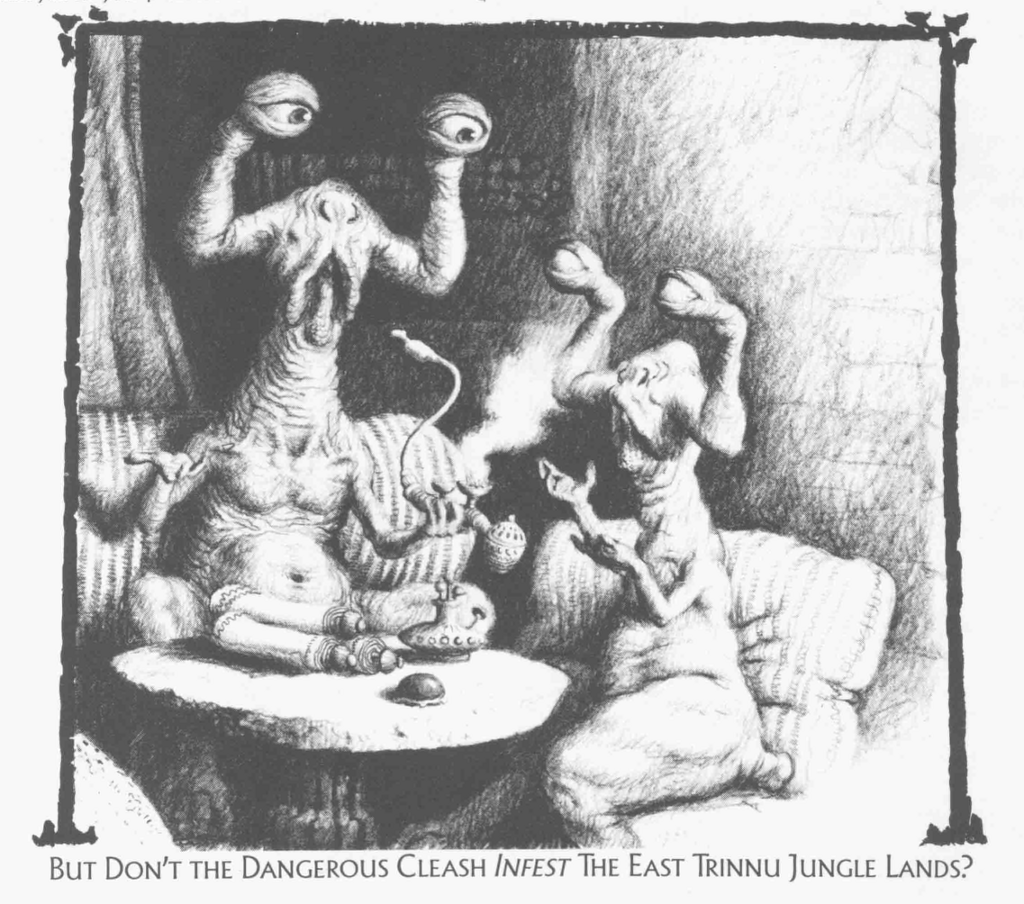
420, smoke Giggit everyday.
Thriddle are a peaceful, benevolent race (I'm sure they are but what race would describe itself as “We are an evil, conquering race of baby killers”?). There is never any reason to fear a Thriddle as they practice no acts of violence. They are known for their desire for knowledge and their fondness for the arts, sciences, geography and languages. They live in Tan-Iricid, the mountain crown which is far to the west of Burdoth.
In Tan-Iricid is Jorune's greatest repository of knowledge. Any can enter provided they display their “Giddyne” (kinda like a library card shaped like a necklace). Kirra mentions that while Thriddle language is difficult, mastering it will open large amounts of knowledge as many books are written in their language.
As a whole the race remains neutral in wars and serves as collectors of knowledge. One of the means of information collection they employ are the “Querrid”. These are people from all races employed by Thriddle to gather information on many different subjects.
The finest gift for a Thriddle is the larvae of 'Giggit” (see next entry). They squish the larvae into their pipes and smoke them, producing “a pleasant frame of mind”. Many Thriddle can be found travelling the East Trinnu Jungle Lands in search of Giggit. The recent Cleash infestation there has made this difficult. Aiding a Thriddle in this land will net you a friend and a reward.
GIGGIT
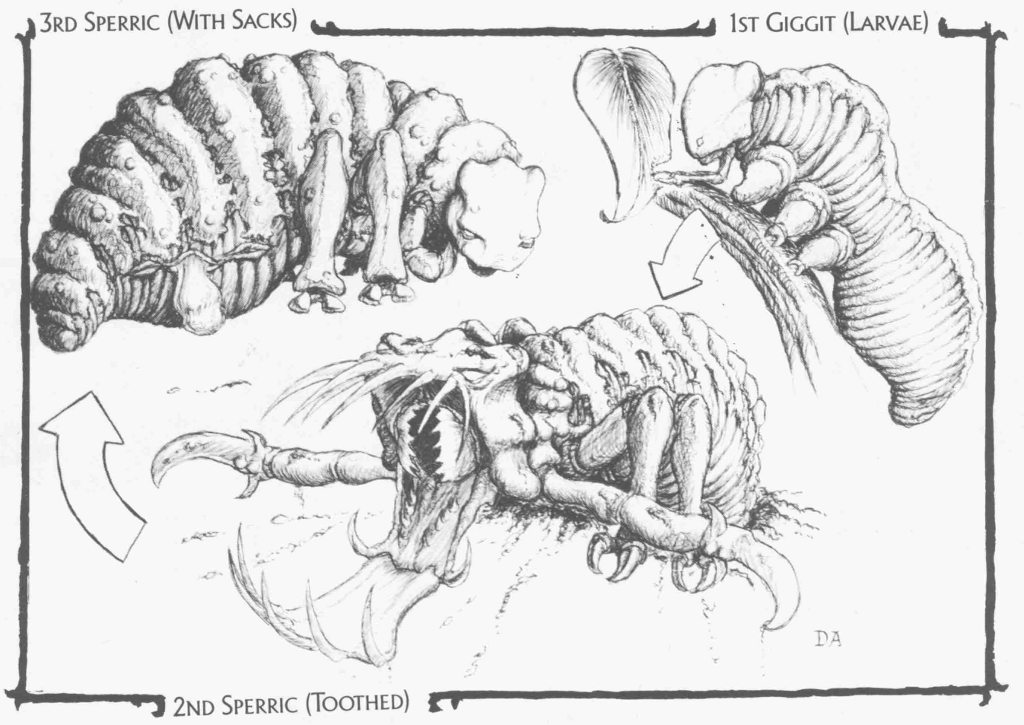
Would you smoke that?
“The larva; Giggit is to be sought, the sleeping Giggit is to be undisturbed, and the fanged Giggit is to be feared.” Gotcha.
These things are about cat-sized in stage 2 (fanged) and the stage 3 version is sought by the Cleash as a delicacy. They burrow in the earth between stages and some unfortunate gatherers transported stage 1 larvae only to find toothed beasts when they arrived at their destination.
CLEASH
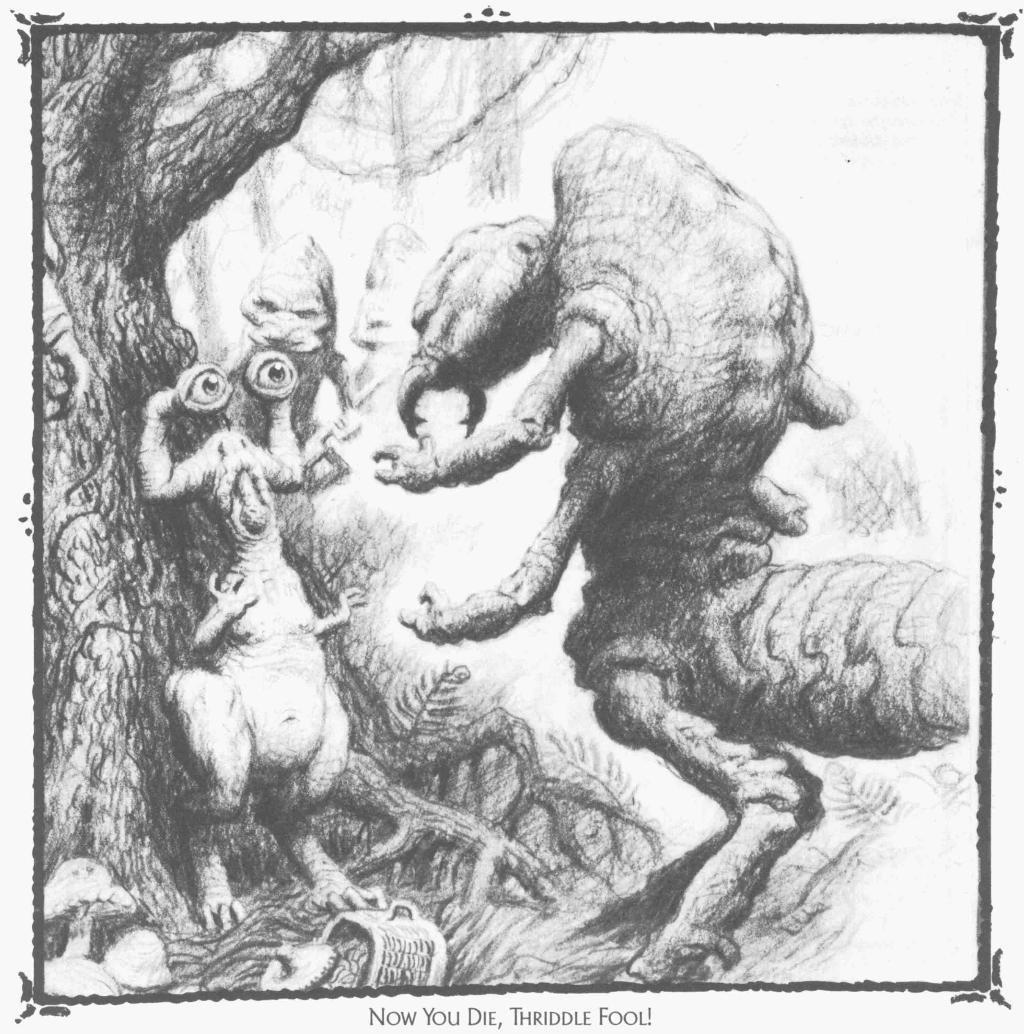
Bad day for a Thriddle
The Cleash inhabit regions seemingly hostile to them and rarely encountered outside their borders. That is until recent times where they are more often seen in the Jungle Lands. No one knows why. They are violent, the worst enemies of Burdoth and have no desire to communicate with other races. While about as large as Boccord, their shape is totally dissimilar. They use “capsules” that are thrown to produce cold, heat and death. These capsules are produced by the creatures themselves.
Oh, and they also kill their own pre-hatched youngs to create their currency. You know, just in case they weren't evil enough.
SCARMIS
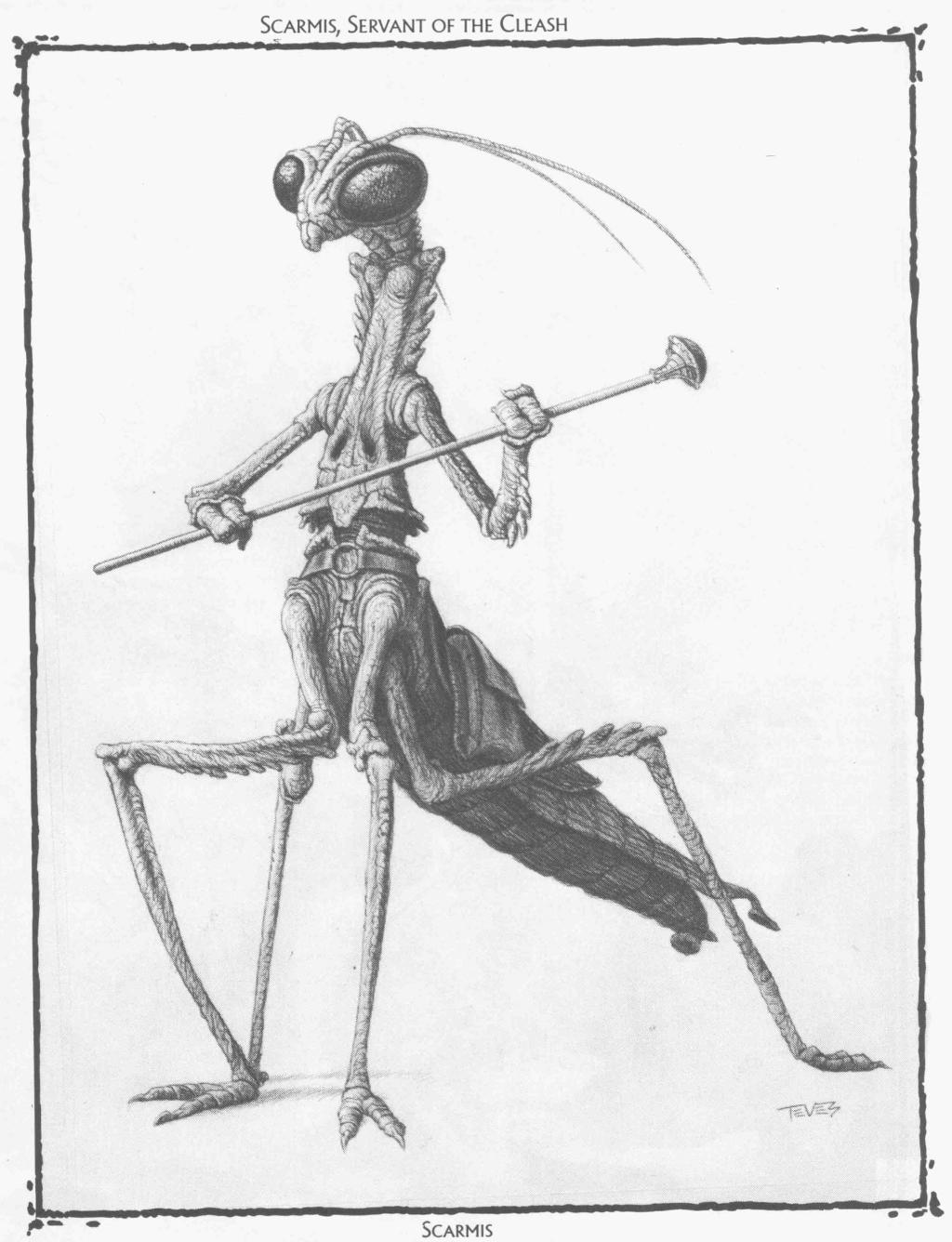
Would you trust this guy?
Where there are Cleash there will be Scarmis. Alone Scarmis present little danger but something in the Cleash's makeup enslaves them and allows the Cleash total control.
CRUGAR
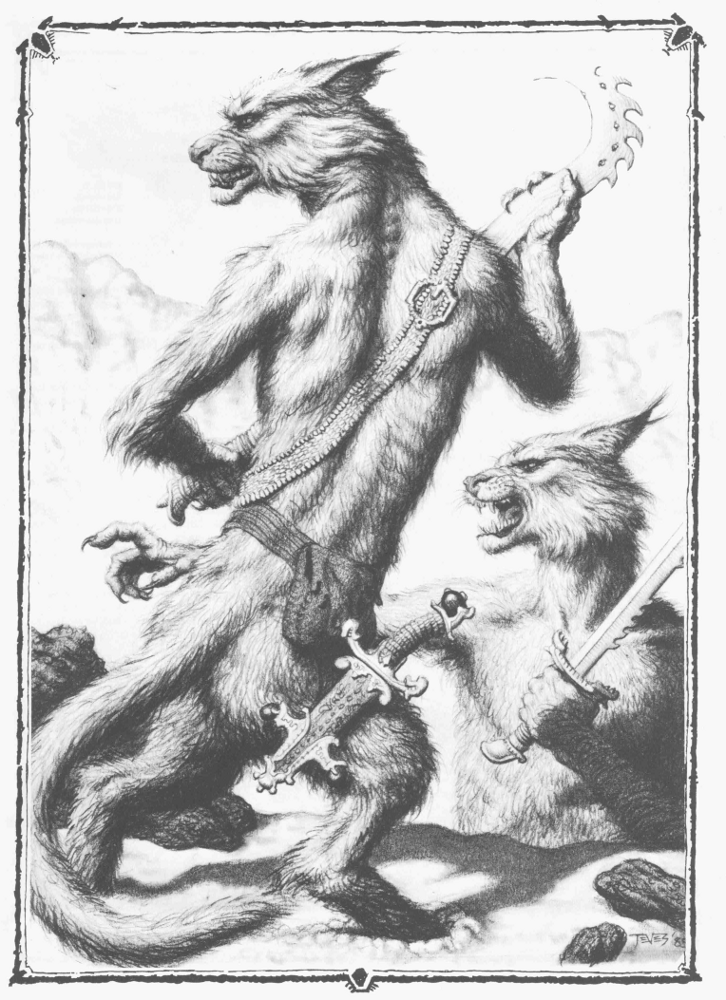
Did furries exist in 1985?
Crugar are one of the races created by the scientist Iscin after the loss of the colonies. They live mostly in a region called Temantro, far to the west. We are told to beware the Crugar for their words are twisted and their moods sudden. In the past they tormented Woffen (see below) and a Crugar killed Iscin, their creator.
They sometimes go on all 4 in the middle of packs of regular cougars to fool intruders. Upright, they carry hooked swords and sometimes know Dyshas from Desti. Once combat begins they will show no mercy until their cause for combat is satisfied (often a slight due to someone mispronouncing a word in their language). We're told not to flinch or back down when facing Crugar.
CORASTIN
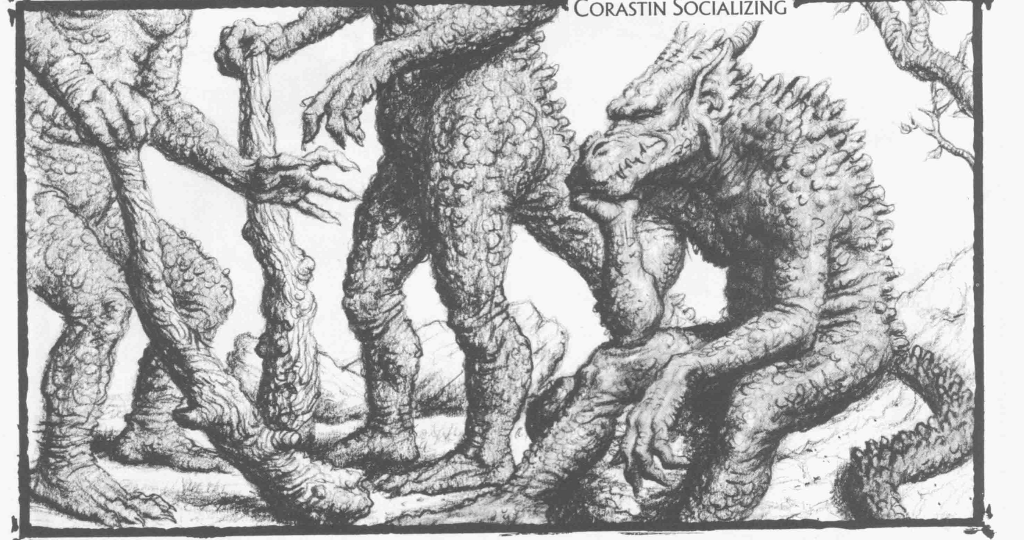
Look, Ma. No pants!
Corastin are the bulkiest race known (and are apparently not an Iscin race based on crocs or something). They are often laborers, construction workers and body guards. They have poor eyesight and hearing but their size is enough to intimidate most troublemakers. They are widespread over Jorune and are very territorial. They value their privacy and it is not recommended to take Corastin on extended sea voyage of more than half a day.
Like Bronth, Corastin abhor slavery. It is wise to not demand labor from them but to treat them as equals, lest one becomes pulp at the end of their sticks (often a tree). Thriddle and Corastin get along well since Thriddle are unctuously polite and Corastin respond with enthusiasm when treated and paid well.
BRONTH
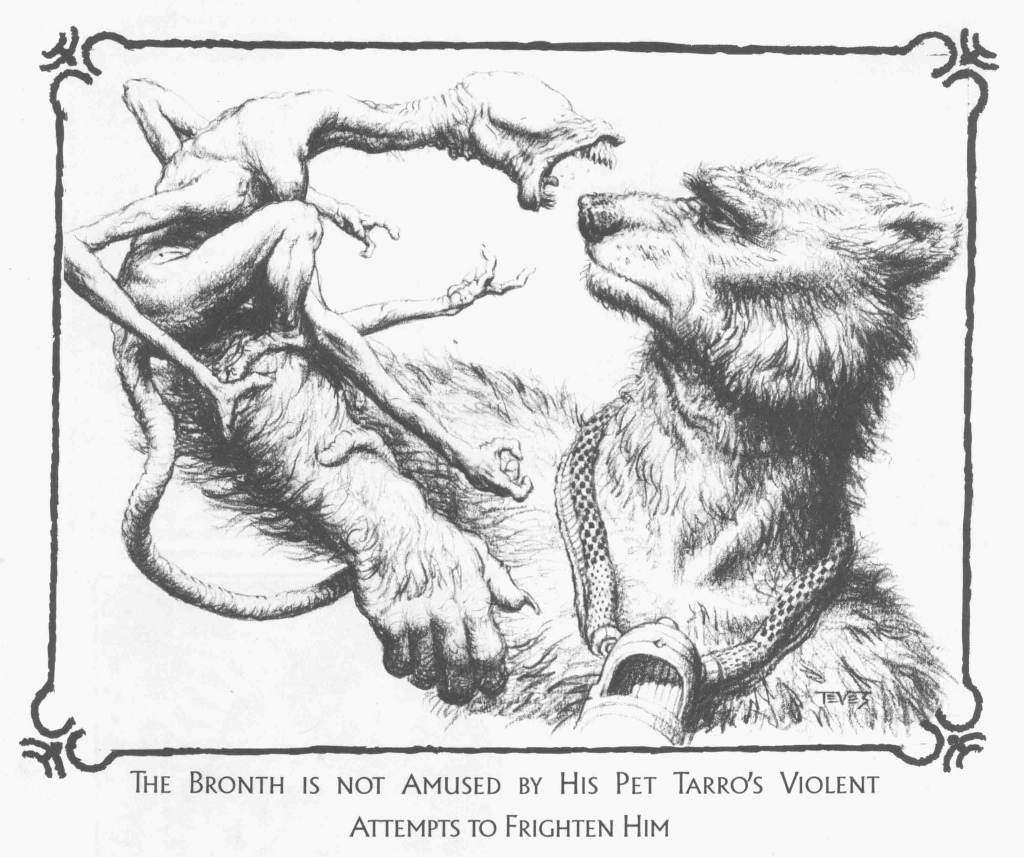
Bronth are an Iscin race descended from bears. Their language, Boru, is strong and somber and often considered the best at relating historic events. Bronth follow the values of chivalry and honor instilled by Iscin more than the other Iscin races.
Bronth are taller than Boccord and people making their acquaintance are to be treated as equals until proven otherwise. They hate the Crugar since they long-ago enslaved the Bronth after killing Iscin. This outrage has never been forgotten.
The realm of Bronth is Dobre and is open to all. Bronth have a seat on the Burdoth council of 10 and they respect the citizenship process. Ramians are despised by Bronth and the Ramian trade with Ardoth is a cause of some friction between Bronth and humans.
WOFFEN
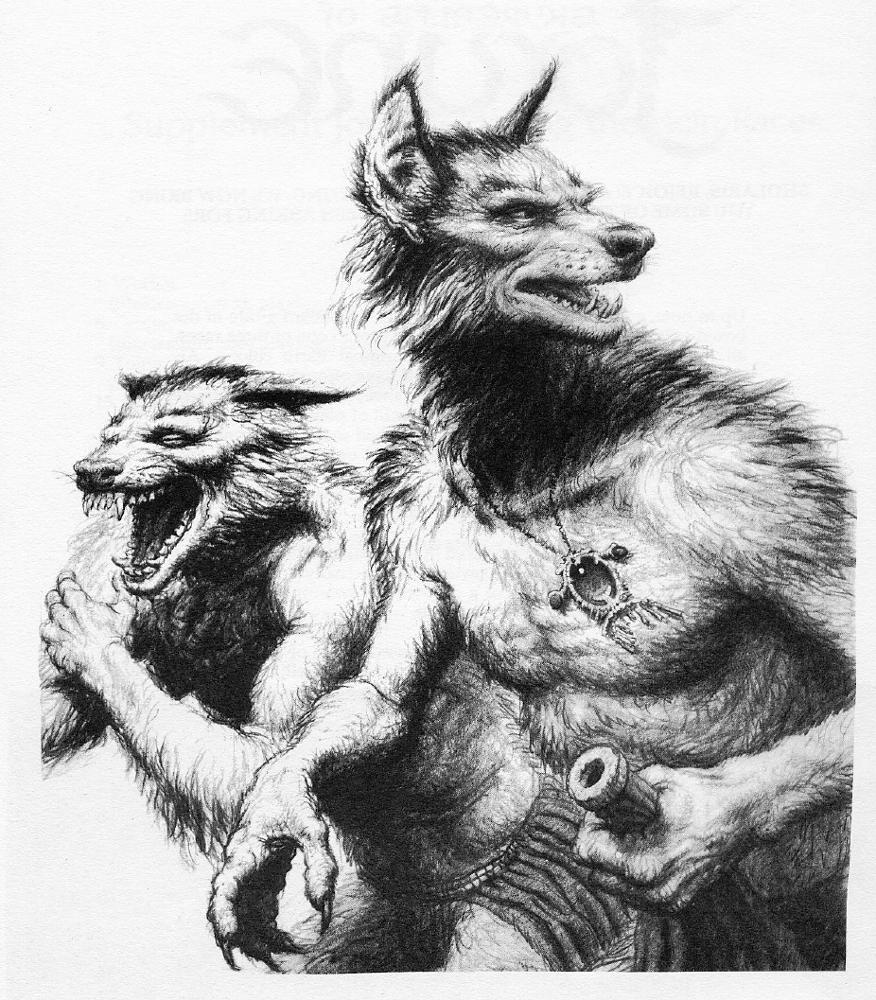

Woffen are also children of Iscin. They have keen hearing and smell almost to the level of Tra-Sense. They have a seat on the council and a common sight in Burdoth. Their realm is called Lundere and is even father than Dobre.
Although they take interest in the affairs of Muadra they are more inclined to spend time with humans and Boccords. They do respect Caji Muadra for the intervention of Caji (the person) in a plague centuries ago where Caji saved many Woffen lives from the Crugar. They also blame Crugar for the death of their creator.
They tend to indulge in food and drink. Their drink of choice, Stomeh, has a tendency to make them over-indulge to the point of creating the “Authew” or wretched ones who are liquored up 24/7.
CROID
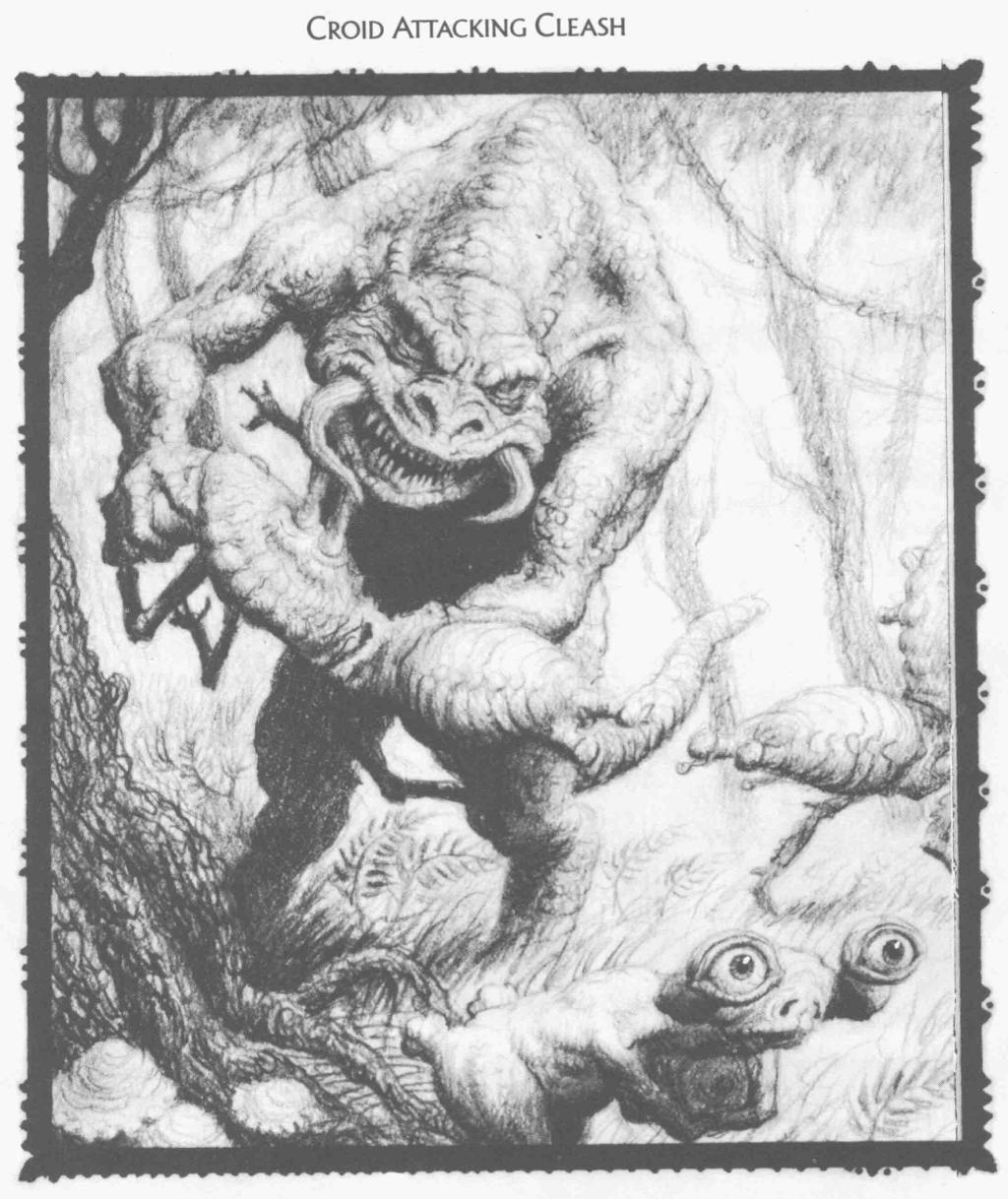
There's always a bigger fish
Croid are not as slow as they make themselves appear. Once a prey is lulled into a false sense of security they lash out with surprising speed. They usually have no weapon but their powerful arms and a makeshift club. They are armored with natural crudge armor.
This armoring is a blessing and a curse, it react very poorly to cold. When treated to cold, it grows quickly creating a powerful itching sensation. This can be exploited with freeze Dyshas. Because of this they are found in temperate climates.
They enjoy a symbiotic partnership with Scragger. (detailed in part 2) Their armor grows quickly and Scragger attach themselves to the Croid, gorging themselves on it. When a Croid grows tired of the Scraggers they simply pluck them off. Beware the unattached Scragger.
THIVIN
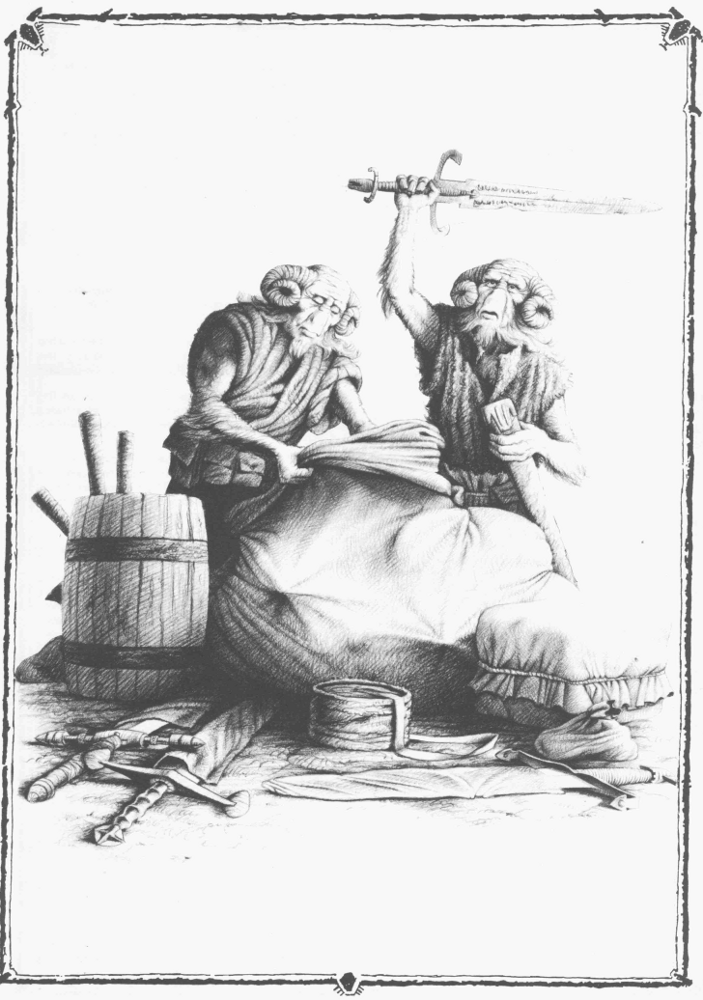
Surprisingly maybe, they are not an Iscin race descended from goats. We are told to not direspect the Thivin but to watch our yules (money) around them for they are shrewd merchants. Thivin have a strong love of music and are masterful craftsmen. Possessing Thivin art is seen a sign of taste.
ACCUBON
(no picture)
They live in lakes and do not appreciate intrusion. They produce the beautiful opaline coleel that they sometimes trade. It is almost impossible to learn their language and they do not know Entren (basic) so communicating is through gestures – which can cause insult to the sensitive accubon.
SHANTA
Nothing is said beyond that they have a complex language, even for Thiddle and that it is now rare to encounter one. We're also told to respect them since they have the greatest Isho sculpting ability of Jorune.
BLOUNT
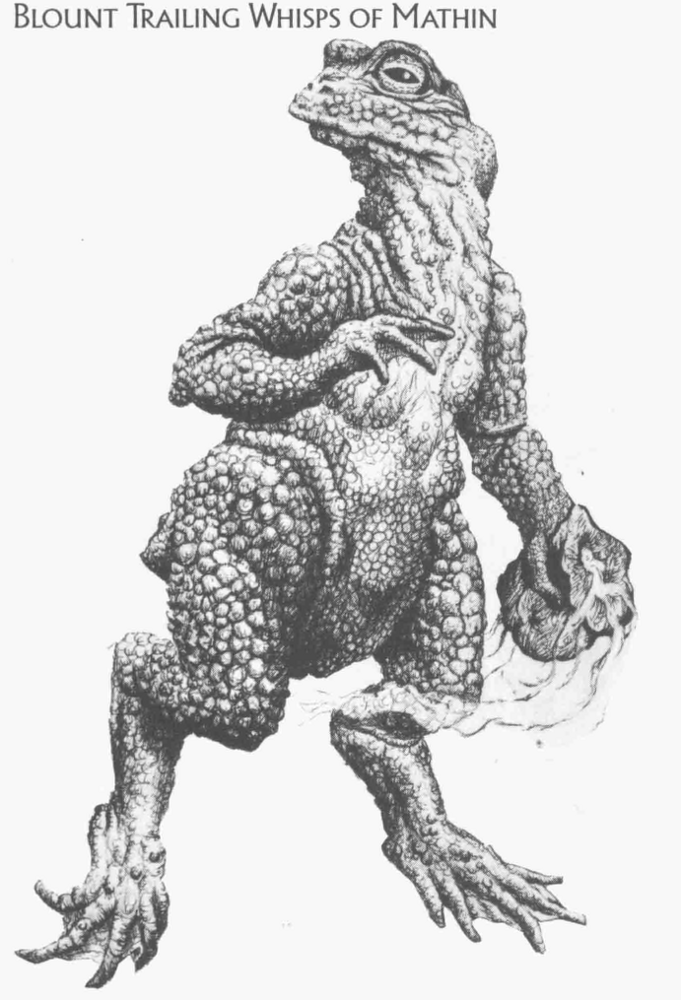
A majestic creature, the Blount
Blount are the first, and least sophisticated, of Iscin's creation. They are semi-intelligent swamp dwellers. They are amphibious and live in mud shelters. They are known for scaring away intruders by trailing powerful stenches on the wind.
SALU
(no picture)
Salu live in salt water and some incleps (inns) in Burdoth have salt water bins to accommodate Salu travellers. They are producers of the Salu Chauis – the fastest sea going vessels on Jorune. They are often for hire as crews.
RAMIAN
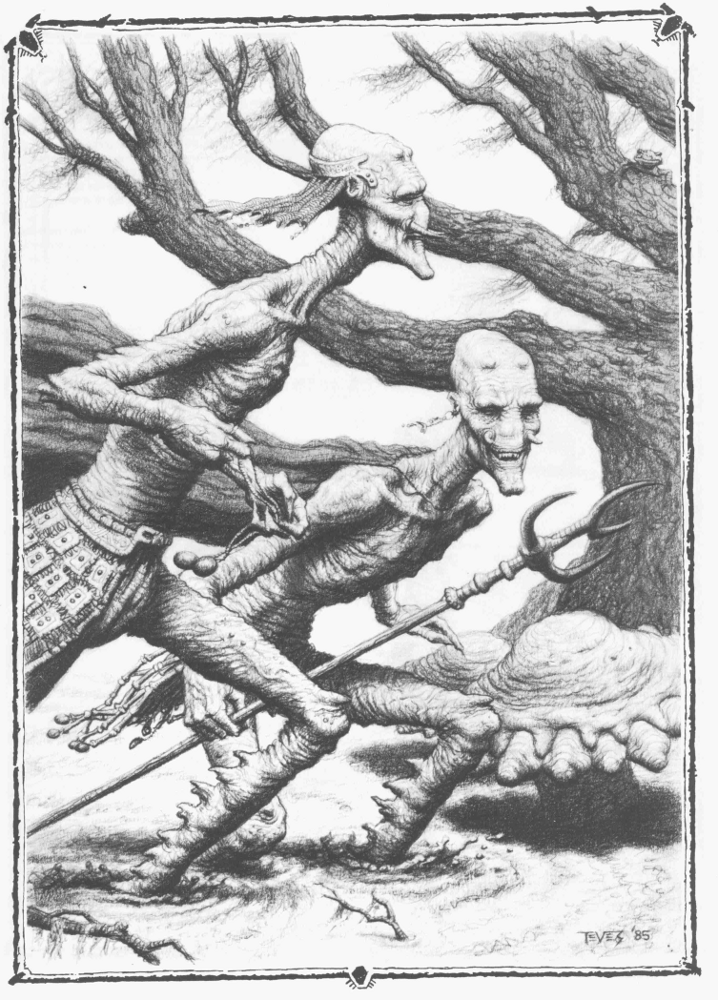
The caption reads: “Rild and Clafe, blood boiling with chiveer passions strike out into the black bogs of Voligire, a relentless unthinking wall of carnal passion.”
Ramian are fairly rare but sometimes seen in Burdoth. Most Ramians are uninterested and not overly hostile. Their bodies stand a full reach above human and hard, crusty bone covers their bodies. They use bolas with great accuracy in combat.
They are to be feared and avoided. They mean you harm. (I thought they were not overly hostile..?). Their home realm is over a month away by sea and their purpose in Burdoth is not a friendly one. We're told to report Ramian sightings to the authorities. Ramians sometimes are called “chiveer” and are known for their bone protusions at the cheeks. Even if a Ramian was guide or friend prior to chiveer he is to be avoided as he is now especially dangerous.
They heal very slowly without the limilate (herb/potion) called “Shirm-eh” and you should avoid letting them possess it. It's said that a Ramian unsure of recovery will never attack.
They can also sense moods and anticipate actions. Dyshas sent their way will be anticipated.
I'll stop here for part 1. Next up, the rest of the Tauther guide.
Next time: The Tauther Guide part 2
The Tauther Guide 2
Original SA post
The Tauther Guide Part 2
The next sections of the Tauther Guide are meant to be narrated by new authors. The first section is from the point of view of this guy:
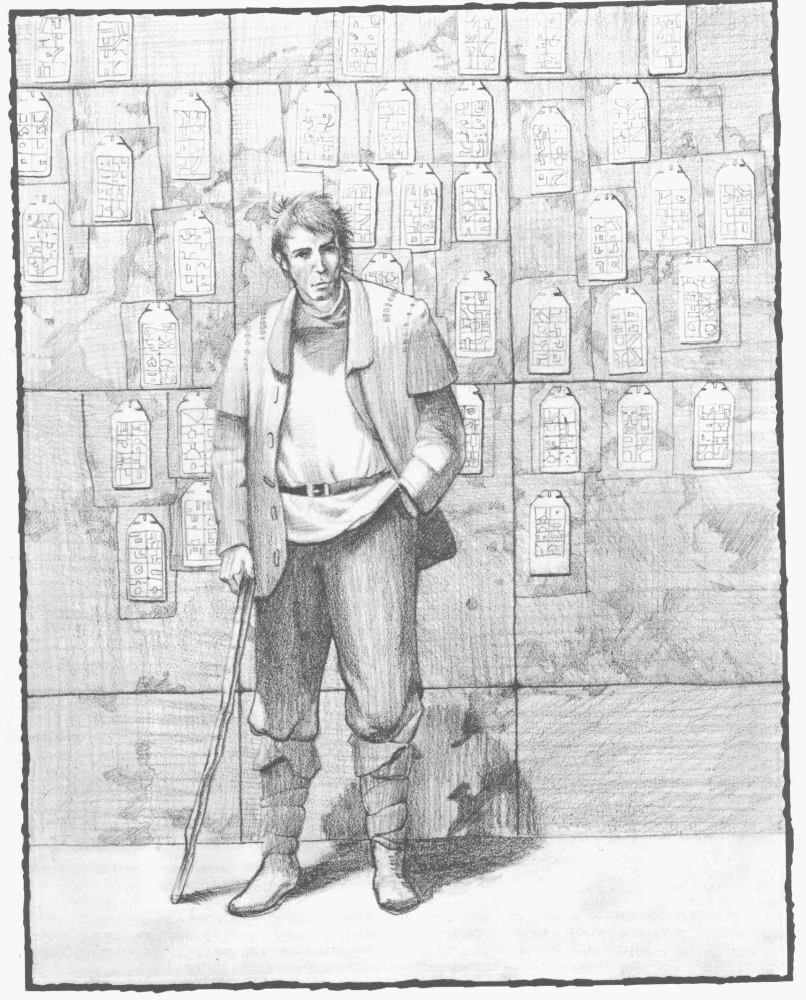
The caption should read: “This is me, Danthro, standing in front of the Drenn wall. I'd just gotten my silver challisk. In those days, I didn't know what glittering metal and boiling water were for. That explains the cane.”
Chapter 3: The Wilds of Jorune
This section is light on images and has very short descriptions of a few subjects.
It basically talks about a few creatures to avoid, like Farg, Scrade, Mandare (“if you end up killed by a Mandare, you did something wrong.” No kidding?), Dhar Corondon (huge beasts with claws harvested to make swords) and basic travelling advice (“watch what you eat.”)
The only interesting entry is the one for “Scragger” and consists of this advice: “Watch the picture”
Here's the picture:
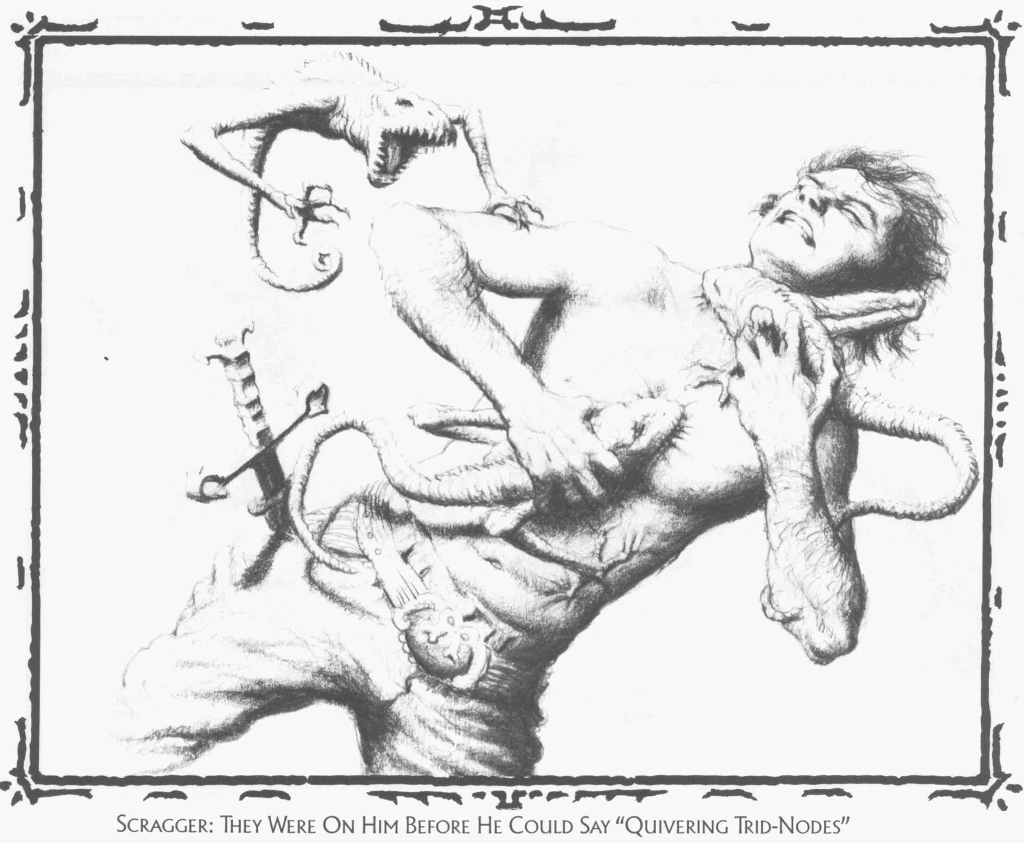
Chapter 4: History
Here we get a timeline and some history lesson. The major points of the timeline are such:
Year 0: War between humans and Shanta. (I almost forgot the H in Shanta. I think a War between humans and Santa would make for a fine RPG setting).
Year 1: Iscin creates blount, crugar, woffen, bronth and tologra (what are tologra?
 )
)
2934: First Muadra (Caji Gends) trained by Shanta for Dysha use.
2946: Caji trains his followers in Dysha use.
3385: Thriddle make breakthrough in mathematics in the theoretical description of warp mapping. No practical application yet.
3391: Thriddle now in contact with various races.
3418: Crugar invade human-controlled regions.
3437: Energy weapons re-discovered thanks to warp mapping progress of Thriddles. Humans begin large-scale takeover.
3442: woffen, boccord, muadra, non-energy humans and bronth for a coalition to halt human advance.
3445: Accords between humans and other races reached.
3459: Muadra veterans of the energy weapon war attack Tan-Iricid, the Thriddle realm.
3460: Muadra attackers contained by Thriddle.
3464: First Cleash sighting in East Trinnu Jungle Lands.
3472: Humans and Bronth attack Ramian ships heading for jungle lands in search of shirm-eh (their healing agent). Northern coastlines of Burdoth, Dobre and Crendor all under siege.
3484: The present.
We then get a few details on some of the major events of the past centuries.
We learn that energy weapons were discovered due to a warp miscalculation by Thriddle. Humans found caches of weapons in sealed containers and quickly made use of them. The current leader of the humans rapidly expended his territory. The alliance of other races proved a challenge to them but one major reason for the stop of the human advance was the first large-scale use of Dyshas by Muadra.
At first these “killer Muadra” caused a panic among the humans and Muadra were banished from towns. They went to ground and passed on their knowledge. Banding with the other races against the humans, they forced the treaty to stop the energy war. The treaty stated that humans could keep most of their lands and rule them but they had to share power with a council of 10 made of most races.
Over time Muadra gained more rights among human cities. Still, to this day kerning bays (to release unwanted energy) and Daijic patrols (special-trained people who can track Dysha use) are still enforced.
Although the human army is still more powerful than most due to energy weapons, they are no longer driven to expand. One of the prime concerns of the human leaders was to keep an active daijic population. This caused some conflict with Bronth contingent since daij meat is needed to have daijic and this meat is gained by trading shirm-eh in exchange to Ramian. At present there is an accord banning this trade.
Even with all the gains made by Muadra they still have a lot of restrictions. For example it is illegal to use Dysha in towns outside of kerning bays unless one has a permit. Muadra can also only give one recommendation for citizenship per year, compared to 5 for Boccord and humans.
Chapter 5: Geography
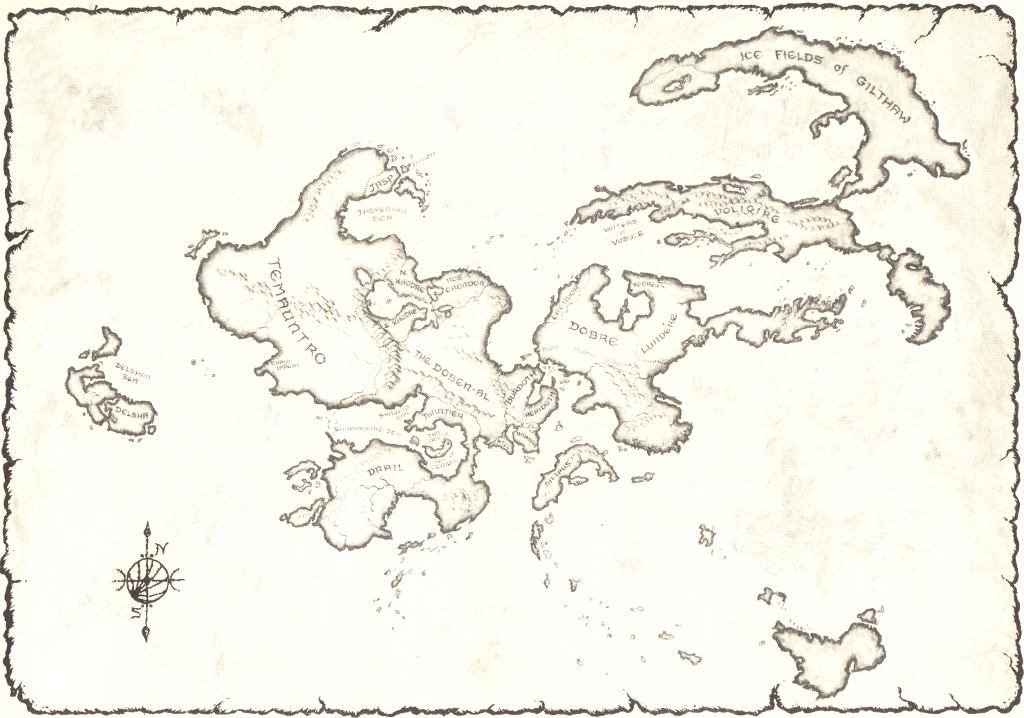
A map of Jorune
Here we get some more details on realms and cities surrounding Burdoth.
HERIDOTH : to the immediate east of Burdoth, this realm has been ravaged by war everytime Burdoth had a conflict. They share little of the Burdothian values and is fragmented and heavily patrolled.
ANASAN : Large but with a small population, this realm has a conscript military. All who pass through this land may be drafted.
DOBRE : The realm of the Bronth. Self-governed and friendly to Burdoth.
THE DOBEN-AL : populated with Crugar bands and under little control by Burdoth. The land is unstable and often shakes with tremors. Isho-weak it nonetheless sometimes has large Isho storms lighting up the sky.
TEMAUNTRO : The Crugar wilderness west of Khodre. Full of grassy plains, rolling hills and high mountains. Has large crystal deposits.
ROS CRENDOR : The realm of the Boccord. Tribalistic, isolationist yet well organized.
CRENDOR : A Bronth realm, home of their military base.
THANTIER : human only (no Muadra or Boccord) realm. Not on good terms with Burdoth. In Thantier, Drenn status is not observed. No one would cross this realm but it is the only means of access to the Thriddle realm of Tan-Iricid.
LUNDERE : The Woffen realm. Mountainous terrain. Friendly to Burdoth.
JASP : A realm where all human sub-races are on equal footing. The capital, Aylon, is described as the most beautiful on Jorune.
TAN-IRICID : The Thriddle realm. A center of art, language and science. Thriddle have dealings with all the realms and are often used as advisors.
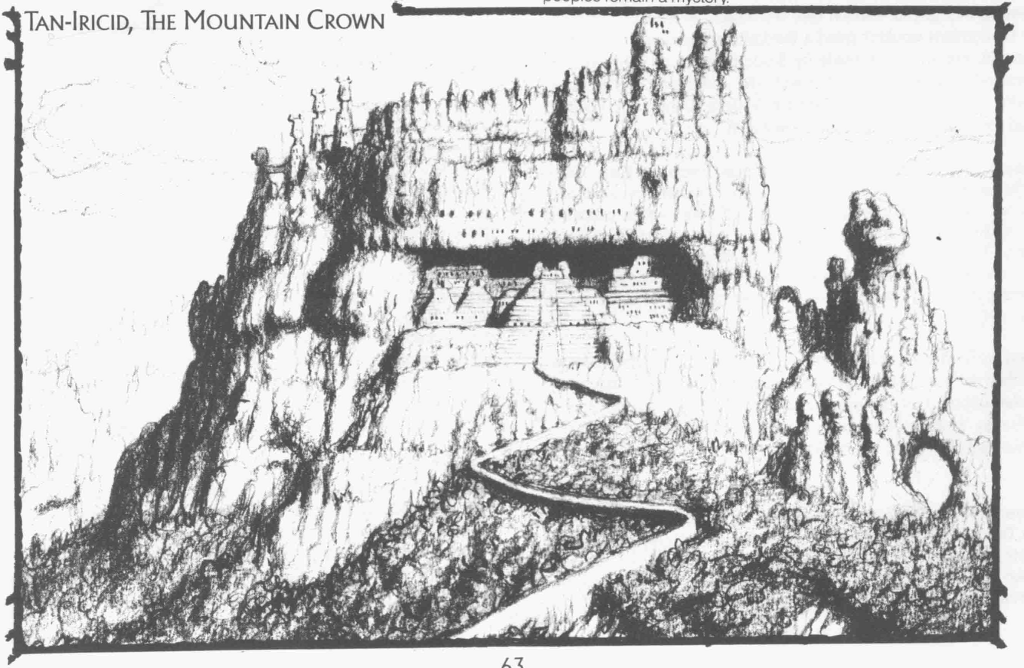
SILLIPUS : A south sea island that is restricted. Ramians and Cleash infest the waters are cruel treatment is given to all who tresspass.
VOLIGIRE : The Ramian realm, north of Drobre and Lundere. Travel there is prohibited by the Burdoth council.
ICE FIELDS OF GILTHAW : Home of the Cleash. Travel to this realm or trade with the cleash is punishable by death.
DELSHA : A far-west island. It's people and culture are a mystery.
Chapter 6: Cultural Notes
Here we get a few words of advice from Keshtia Marilis Mishayne (pictured below).
Thriddle sit only in friendly company.
Muadra should display their Naull when presenting themselves to a group.
Look Bronth in the eye.
Woffen have a tendency to overindulge. Help them overcome this and they will be grateful.
Scarmis not directed by Cleash are not so dangerous.
Corastin accept tribute. Quantity not quality is the key.
Never demean the work of a Corastin.
Ramian in chiveer are fair game. Bounties on chivs are common.
Tauther should display their challisk proudly in all lands but Thantier.
Tauther must defer to Drenn where appropriate.
Tauther are to uphold the yords (laws)
Watch for miscommunication in all languages, especially Crugar.
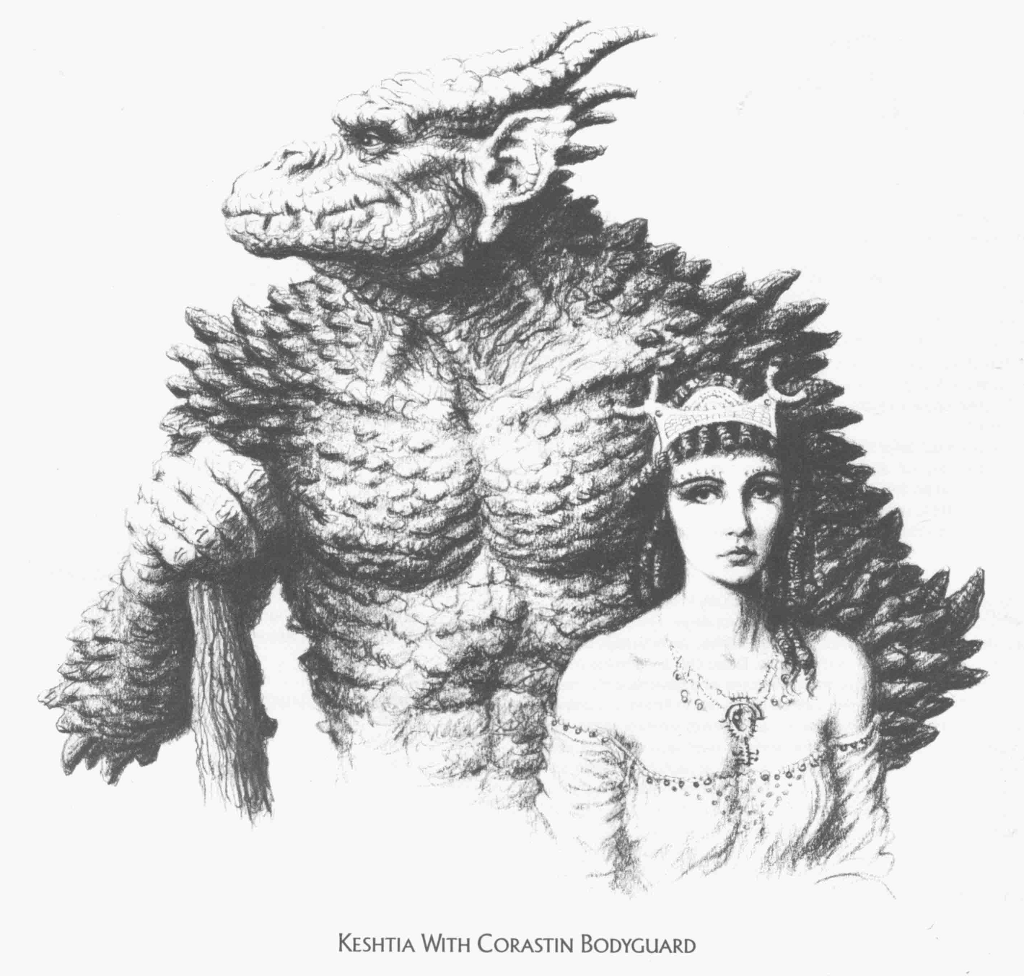
And that's it for the Tauther Guide. As a player this is all you would get to read. It's probably sufficient for a character's knowledge but, as a player, I sure would have some questions left.
Why are there so many intelligent races?
Where do they all come from, they're clearly not all Jorune native?
The character sheet lists human, Boccord, Muadra and “Other” for player race. Yet the book so far only gives rules for the first three. What's up with that?
Why didn't the designers put the damn glossary at the beginning of the books?
A PC can only come from Burdoth and his only motivation is to become a citizen?
Will we get answers to these questions and more in the Sholari Guide?
I guess we'll find out because...
Next time: The Sholari Guide
The Sholari Guide
Original SA post
The Sholari Guide: GM advice and Intelligent Races
We come to the Sholari Guide. Reserved for the GM of the game this book, we're told, contains information about being a Sholari, the various intelligent races, creatures, items and locations.
Chapter 1: Learning About Sholari
This is a pretty standard advice for GM section. A few things stand out as GM-vs-Player, which was fairly standard for the era. We're told that the Sholari will need to be a referee, judge who deserves what, and that the Sholari will need to spend time outwitting players who feel they need to “win” the game.
We then get a section talking about major Sholari responsibilities and one of them is Social Acceptance.
The author sees this as one of the major themes of Jorune and a key to success for players. Each time someone endorses a player's bid for citizenship (by marking the PC's challisk), the character's Social attribute goes up by 1. When social has reached 50, hey may apply for the citizenship test. This is not RP'd (of course not) but a roll on d100 under 75% base chance (of course it is).
For every point of social above 50, chances go up 2%. They go down 10% for every point below 50. The test can be attempted only once per 10 game months. Once Drenn, players should enjoy major responsibilities and apply for energy weapons.
The last bit of advice for this section is this: “ Don't let players kill Shantas or other forms of respectable life with energy weapons. ” We're not told exactly why except that characters who go on killing sprees should be stopped.
Chapter 2: Encounters
This is a pretty boring chapter consisting only of tables and charts to generate random encounters. I guess I'll roll an encounter.
Start by rolling how the encounter starts (1d100). A roll of 26 means it's a case of mistaken identity. Then we roll for response (d100). 10 gets us “wants to avoid contact.” The next step is rolling for quirks (1d6 and 1d100). Rolls of 6 on the d6 means roll twice with the d100. The d6 rolls a 3 so we'll roll the d100 once to get a 57 . This means that the encounter plays a musical instrument.
Then we roll to see what the encounter actually is by rolling a d1000. 190 nets us trading Thiven (1d6, result of 4) on a mission of (roll d100) being a courier (roll of 47 ). The quirks of their party is ( 74 roll on d100) that they are poorly groomed.
So our encounter starts with the PC encountering a party of 4 poorly groomed Thiven that are playing music on their way to delivering a package. They want nothing to do with the PCs but mistake one of them for someone they know and, perhaps, deliver the package to them. There are worse encounters I could think of.
Chapter 3: Intelligent Races
This chapter gives more details for the intelligent races presented in the Tauther Guide. We get stat blocks and longer descriptions. Although most of the descriptions are rehashes, I'll try to point out the interesting new stuff for the races that have some. Unfortunately, most of the art is recycled. For pictures, refer to this post:
Oh, and we also get the height chart again but this time we know who's who.

From L to R: Crugar, Woffen, Bronth, Boccord, Human, Muadra, Shanta, Thriddle and Cleash.
ACUBON/SALU
Here we learn that these two races branched off the human stock in the early days. They are both water breathing and, after a week out of water, they have to spend a day per week out acclimating to water breathing again.
BOCCORD
We learn that Boccord value “kree” (worth) above all else. A craftsman that makes amazing chairs would have the same or more kree as an honored general.
BRONTH
Bronth are 8 feet tall and can weight up to a 1000 pounds. Their realm is near a waterway that Ramians use to sneak into Burdoth. The weather makes it hard to see far due to fog and whole ships sometimes sneak past unseen.
The Bronth are the scholar of the ancient Iscin legends and ar epartial to pets. They see no conflict between their abhorrence of slavery and keeping pets as they treat them very well. Their capital is a major center of trade and commerce with an architecture scaled to their large size – although most everywhere scales up for Bronths.
They are omnivorous and are found of Durlig (that human created plant) of which they most enjoy the boild down goop left at the bottom of rusper (ale) barrels. When craving, Bronth can be found scrapping the barrels outside of inns. So much for the noble historian image.
CLEASH
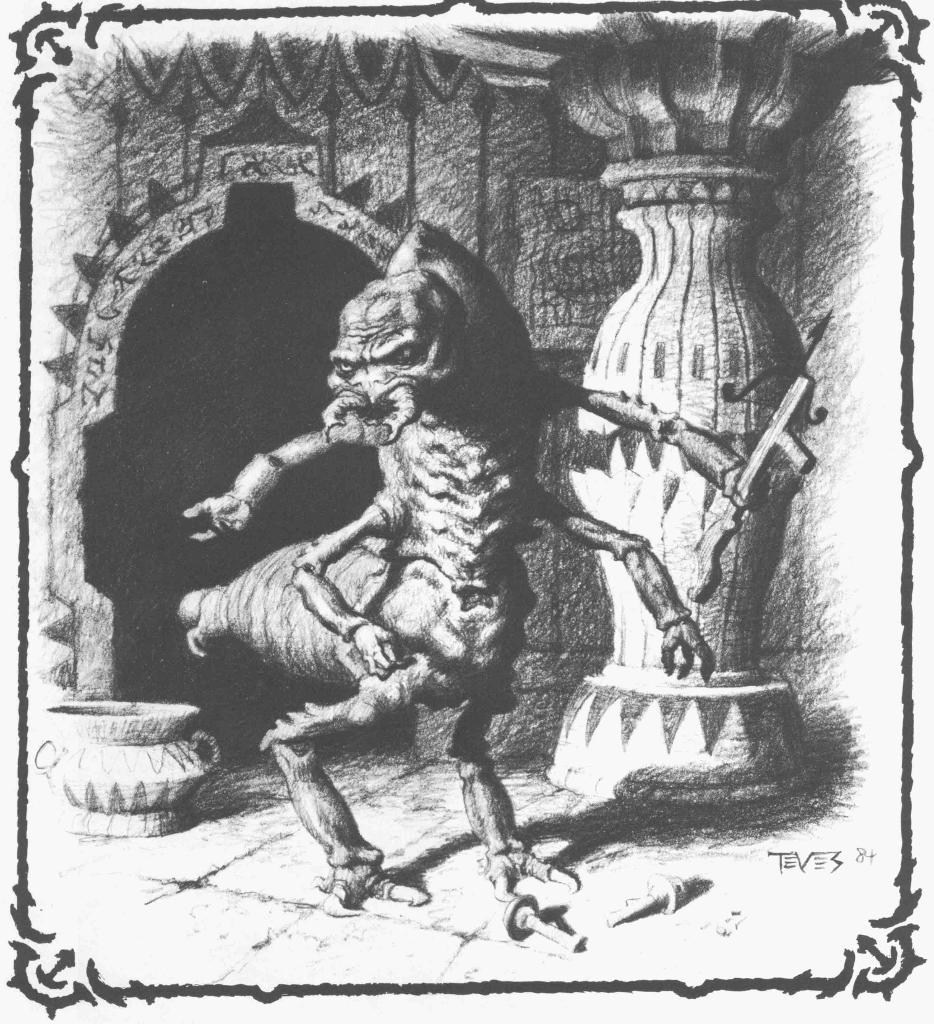
A new picture – a rarity in this chapter
The Cleash were exiled to the Ice Fields of Gilthaw by the Shantas thousands of years before humans arrived. There is no history of races treating the Cleash with hostility yet they always attack on sight.
When the Earth scientists found the Cleash, they were baffled since they seemed poorly suited to their environment and odd bits of machined construction were found in their encampments, signs of advanced technology.
Cleash have short arms poorly made for gripping swords, they prefer crossbows or throwing capsules. These are manufactured but, somehow, the Cleash's biology enters into it. The capsules can be thrown for the same effect as cold, heat and lightning Dyshas (essentially hand grenades). They use the crossbows to shoot the capsules since their arms lack thowing power.
The Cleash can control the Scarmis with their pheromones and the glitter of their humps. It is said that a Scarmis that was docile for years will turn on his non-Celash masters at the first sight of a Cleash.
CORASTIN
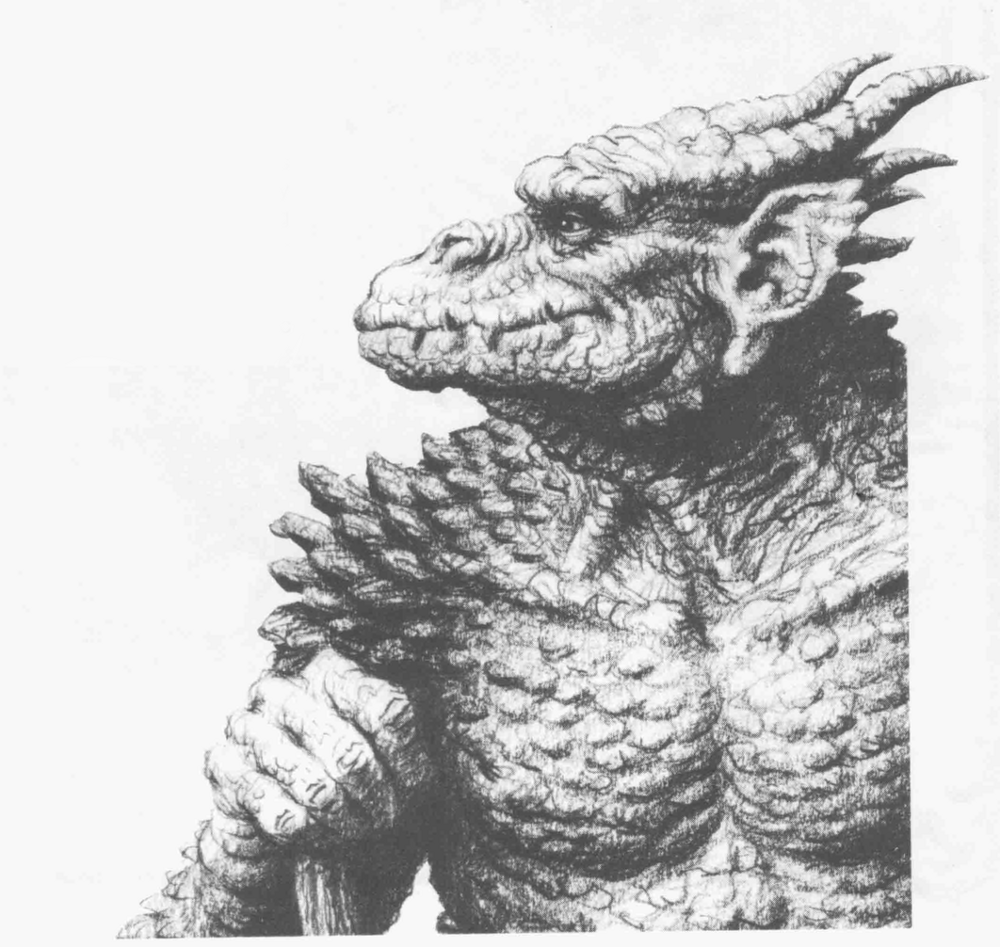
9 and ½ feet tall (the game actually goes between using meters and feet for height), they are the largest intelligent race known. They are the more intelligent relatives of the Croid.
CROID
Not a lot of new information except that we find that the Croid's diet is hardly selective and that they will eat pretty much anything and everything. Also they are semi-intelligent and can learn the very basics of language.
CRUGAR
The Crugar did kill Iscin but they see it as due to a conflict of wills, not malice. They are short haired but they have cousins in the Temauntro region who have long hair. These are called “Cygra”.
Their reason for many of the conflicts with humans is that their land (on which they had settled long ago) was exploited by humans for crystals and minerals, From their point of view, they were defending their homeland.
Their religion celebrated the glory of revenge and righteous action. They see themselves as liberators and not murderers. Crugar are found of using hook-swords in combat.
MUADRA
Muadra who have no Isho or Dyshas are usually poorly educated and mannered. Not being able to produce a Naull is seen as a sign of retardation by other Caji. We then get a table to randomly generate Dyshas for NPC Muadra.
RAMIAN
9 feet tall and very mobile, the Ramians can move at rapid paces of up to 5 miles an hour for 14 hours a day.
While thin-looking, they are as strong and dextrous as Boccord. They mainly use bolas and “hard sword” made of rocks that can be sharpened like metal in combat. They do not flinch when insulted and their behavior betrays little emotion but they have long memories of injustice done to them.
Only Thriddle claim to be able to spot the differences between males and females of the species. A fact they are quite proud and secretive of.
Once every 20-30 years of their 180 year lifespan, Ramian will grow chiveer. This lasts 2 months where they become barbaric and hostile. Ramian able to control this – the chiven rachu-eh – are greatly respected. Much of the hostility of Ramians is due to chiveer. Under normal circumstances minimal trade can be achieved and they are sometimes available as guides and guards.
Among themselves, they exist peacefully. It is said that they share a limited form of telepathy. This has never been proven however but may account for the fact that they seem able to anticipate actions.
Ramians are the only suppliers of the aquatic Daij fish which can allow humans to sense Dysha use, This is traded for shirm-eh, their healing agent. Without it, they heal very slowly.
For some reason Ramians will not enter the Shantic lands in Lundere. Even though shirm-eh grows there in abundance.
SCARMIS
On their own, with no Cleash around, Scarmis are sometimes taken as bodyguards and assistants. They are fast movers but noisy in combat – their legs makes a skittering noise when they move. Nothing is known of Scarmis society if they even have one. They spend their time collecting edible shrubs and wild game.
They can speak their own language and live in dung houses with many twisting passageways. They appear scatter-brained and don't seem to understand much of the civilized world around them. Loyalty is a concept foreign to them.
THIVIN
They are known as traders and artists. Thivin are the creators of Thivin rugs, which contain small insicts that change their skin patter over their thousand year lifespan. This creates an ever-changing rug. Since these insects are woven while in cocooning stage, it has happened, rarely, that owners of these rugs found that their piece of art had awoken and eaten the rug and the furniture in the house.
There is a superstition that warns against harming Thivin. Many swear that their worst misfortunes happened after short-changing or mistreating a Thivin. They are fond of music and gabling and interact well with human society.
THRIDDLE
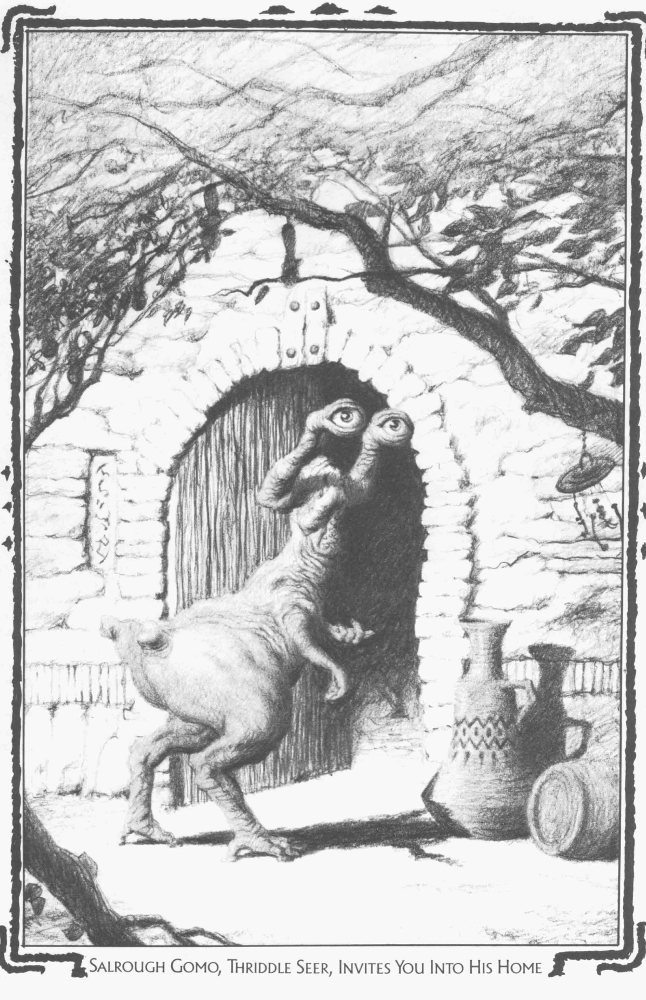
”Hey, little boy. Do you want some candy?”
The “querrid” sometimes employed by Thriddle serve to amass more knowledge for these inquisitive creatures. The questions posed by querrids can range from “what do Corastin prefer to eat?” to “what is the avergage size of a Dhar-Corondon's thailier?” They are masters of science, language and have made great strides in warp mapping mathematics.
Their capital of Tan-Iricid is built to a scale of creatures 12 feet tall. Its origins are murky but it seems clear that the Thriddle didn't build it.
“Trid-Nodes” are the odor-sensing organs on a Thriddles backside and they quiver slightly when Thriddles are tense. Hence the expression “quivering trid-nodes!”
They seldom sit as it takes them a while to get back up. A Thriddle will only sit with friends and never strangers, in case he has to flee in a hurry. Their walk resembles a bird's knee-bend hop movement, a fact they are sensitive about.
Their language is so complex that it is often said that a person will start learning it at the same time as the process to become a Drenn and attain Kesht (honored Drenn) before mastering the language.
WOFFEN
Woffen shed their fur in the hot season and they are not known for their hygiene, preferring to blend in with the smells of nature as they like the smell and it makes them harder to detect.
Most all Woffen enjoy drinking to excess. Those who over-indulge are called “authew”, the wretched ones. They have a high regard for honor and they will never leave one of their own, even the authew.
Their realm, Lundere, has long been known to be a land where great Shantic cities are hidden beneath the soil. Woffen have shown little interest in finding them or letting others do so.
Wherever Woffen live, shenters (bars) can be found. A common custom is to ask a question of all who enter. Some easy, some difficult but rarely predictable. A correct answer will lighten the mood and might get you a free drink. Any who live on Woffen land will pay a tax for the upkeep of the shenter, even if they don't use it. This is seen as an investment in the community.
And that's it for the intelligent races. I would have liked to learn more about the origins of some of them (like Ramian and Thriddle) but, so far at least, the Sholari Guide doesn't provide. The next part will deal with non-intelligent creatures of Jorune.
Next time: The Sholari Guide part 2
Creatures, Items, & Notes
Original SA post
The Sholari Guide: Creatures, Items and Notes
Chapter 5: Non-Intelligent Creatures
Here we have stat blocks and descriptions for creatures of Jorune (and imported ones I guess). The chapter has a short random encounter table to start things with, then it's right to creatures. I won't list them all but will try to pinpoint the more original ones or at least the ones with artwork.
CORONDON
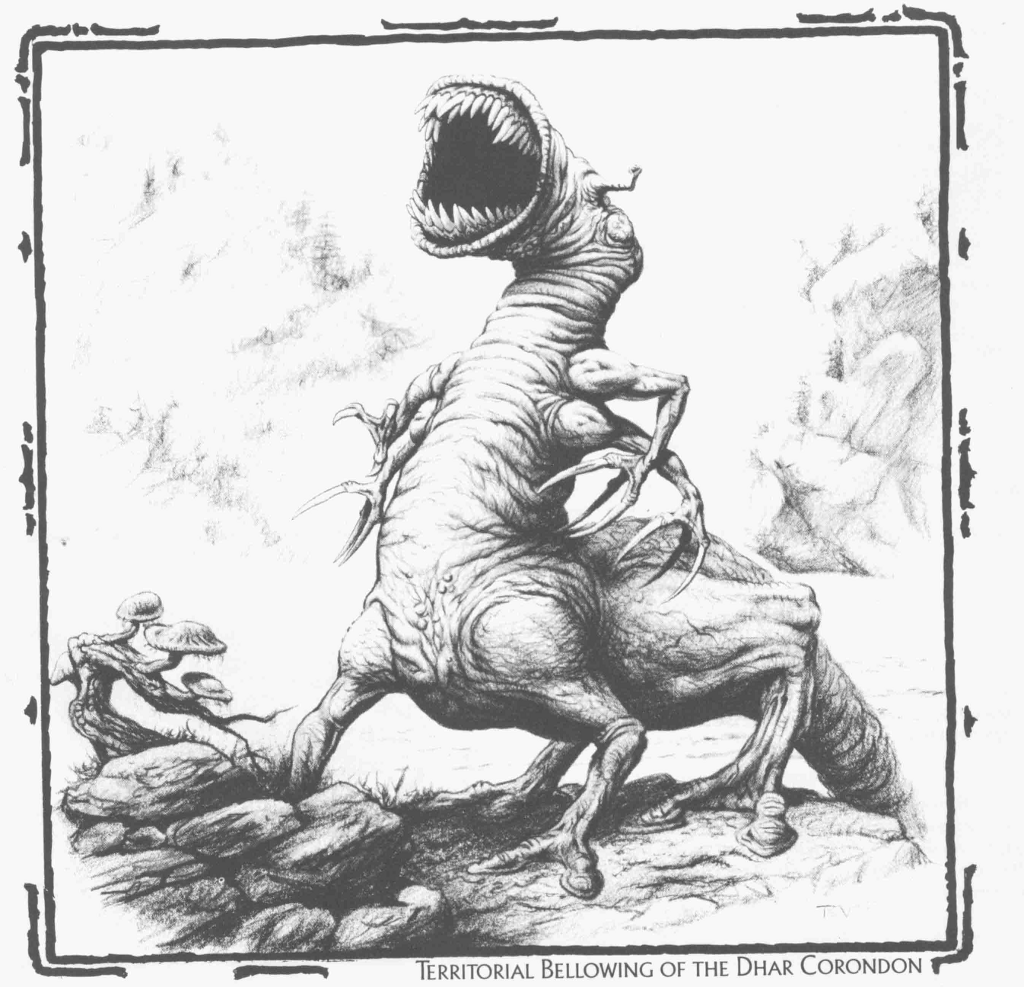
For reference; each claw is the size of a long sword
The Corondon, or Dhar Corondon for the larger specimens, are the inspiration for much Shantic technology and culture. The clwas (thailiers) are used to produce the Shantic swords and it's carapace is used to produce armor.
This thing is basically a blender on legs, They attack with each of their four arms and the little protrusions to the side of the head launch lightning Dyshas. If I had to compare I would guess they measure to encountering a small/medium dragon in more traditional fantasy games.
CRILL
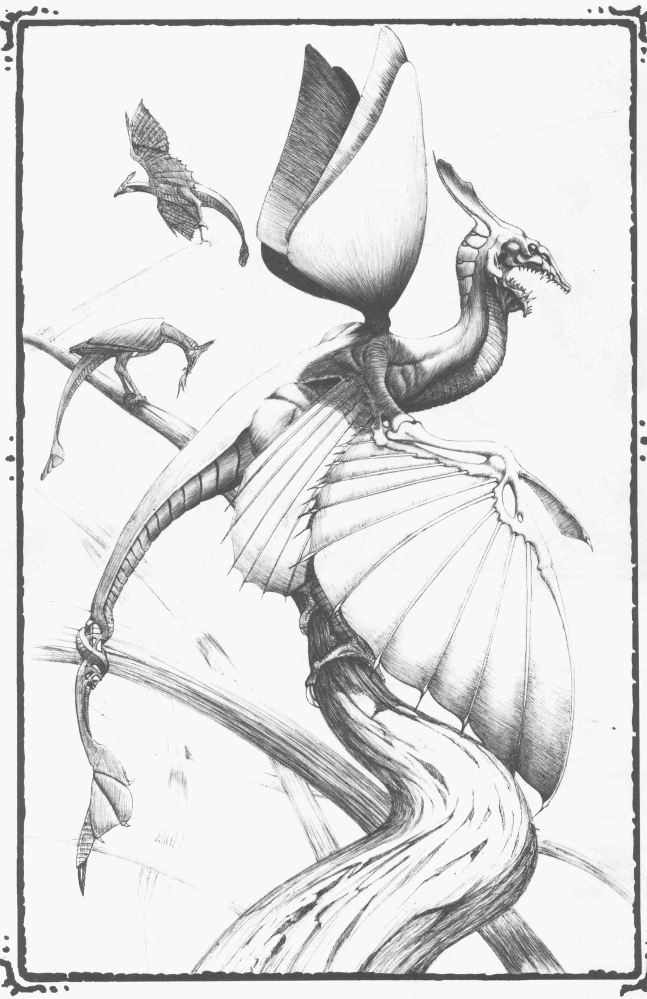
Crill with a “boc-rod” in its tail
These are desert birds that are often hunted for their boc-rods. They are not born with the rods, they plunge their tails into the sand and sometimes emerge with crystals embedded in them. Over time, this crystal will allow them to absorb Isho energies directed at them. It's not clear why they dig the soil with their tails – unless they actually do it to get the crystals I guess.
If you can remove the crystal (and, hey, there's a skill just for that), you'll be left with a foot long crystal that can absorb Isho for a time, making you Dysha impervious.
DICHANDRA
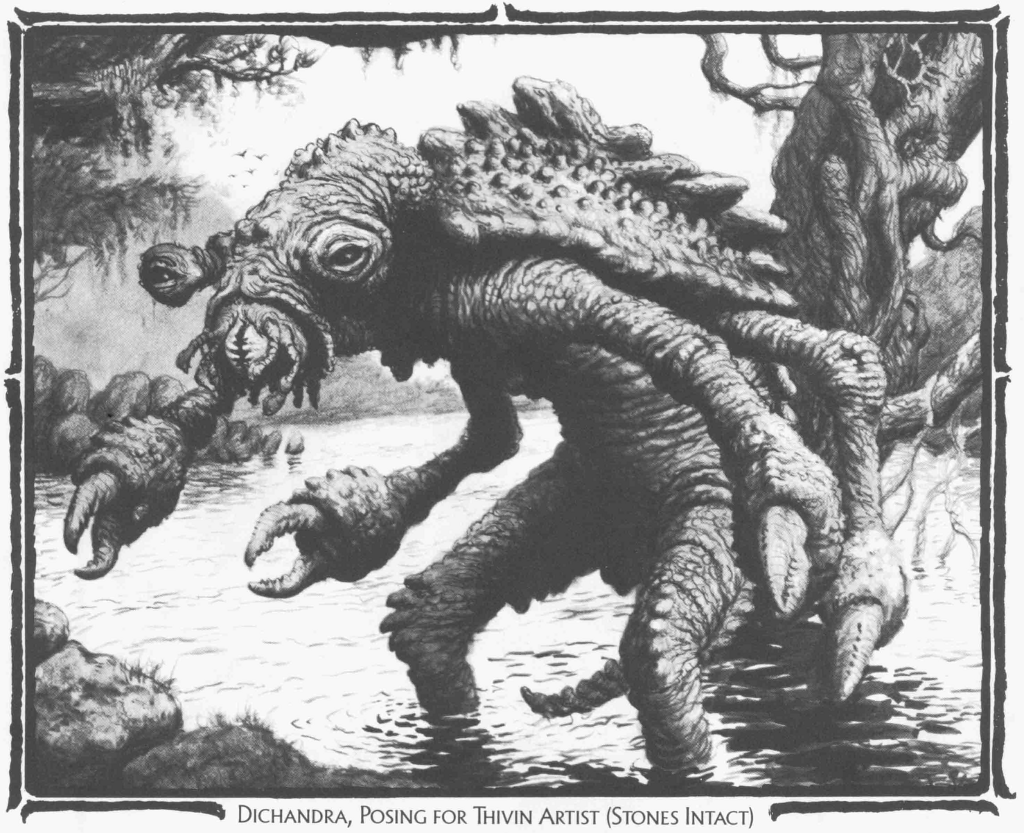
This creature is listed as “will attack on sight” so I don't know why it's posing for a portrait...
They live in swamps, lakes and rivers and will attack by dragging intruders under the surface. They are often killed for their rock-hard wrists that can be used as musical instruments. Boring small holes in them will produce dichandra stones, which can be played. Thivins are good at this.
DREGALMON
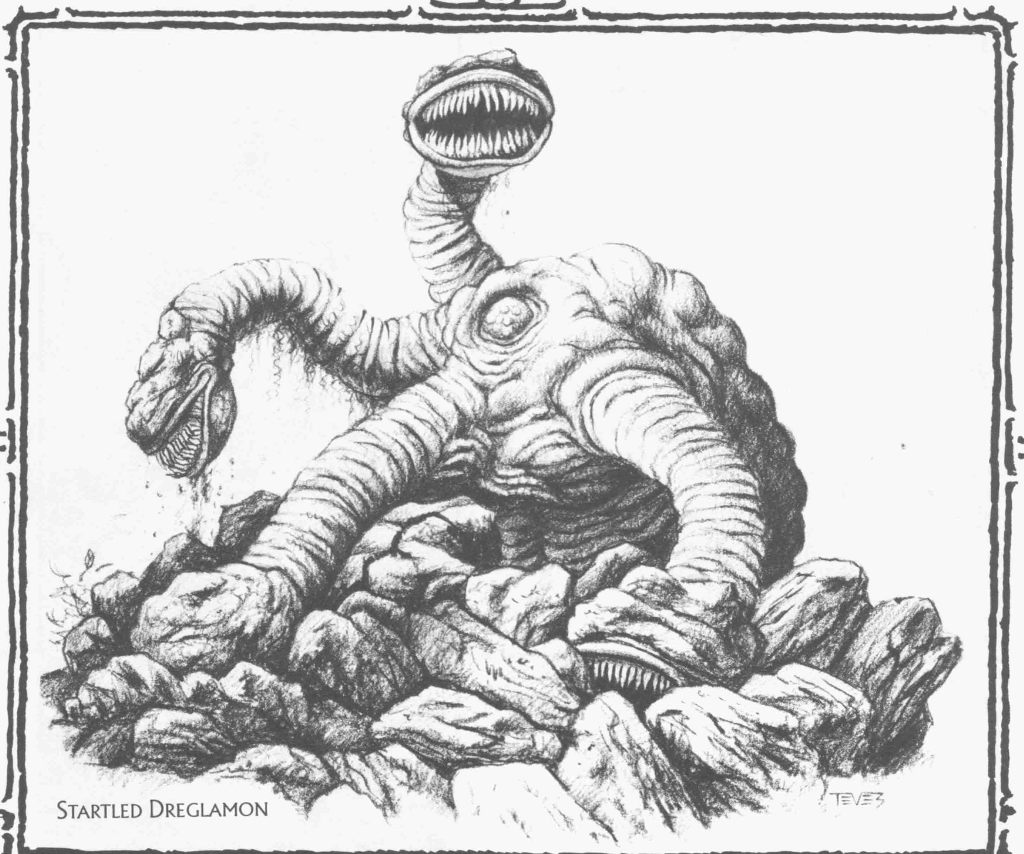
These creatures blend into rock formations and are only slightly mobile. They will attack anything that comes close enough and make a meal out of it. Genderless, their offspring are launched in the air at the end of their 30 year lifespan. This process destroys the “parent” Dregalmon in an eruption of flesh which projects the young up to 500m away. The young then hatch from their armored cocoons and burrow into the ground to mature.
GREY MANDARE
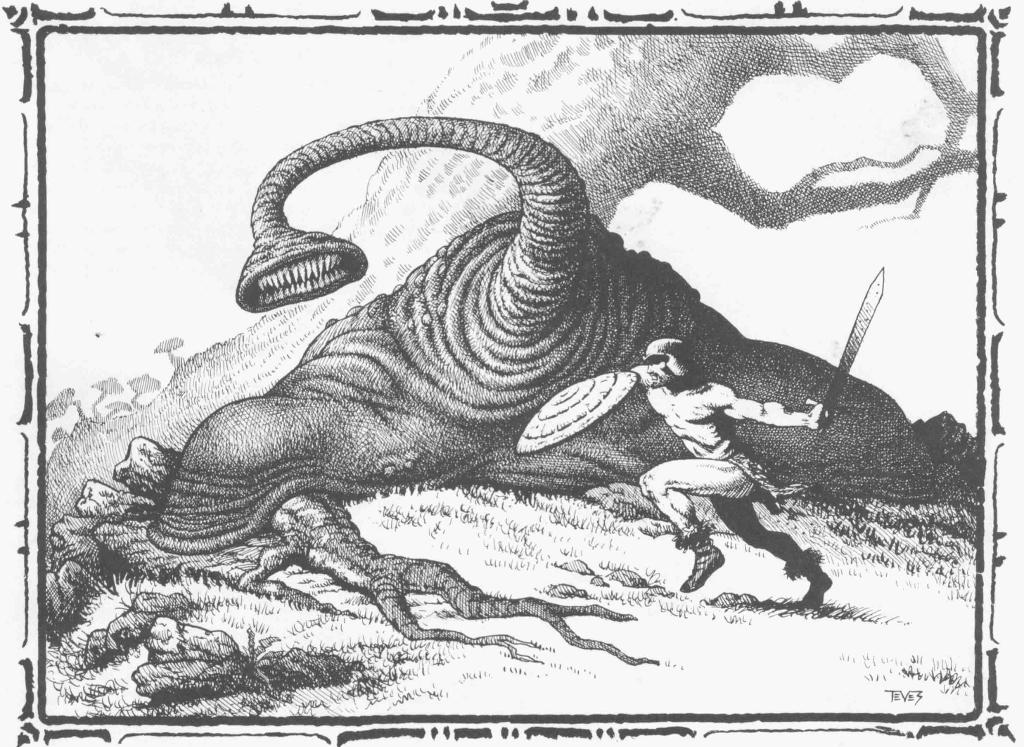
You would think he could simply outrun it
The roar of the Mandare is ear shattering. Creatures have suffered split eardrums at the sound. The teeth of the Mandare remain in their prey after a bite. They are valued as good luck charms since anyone who survives to collect them has to be lucky.
SLUTCH
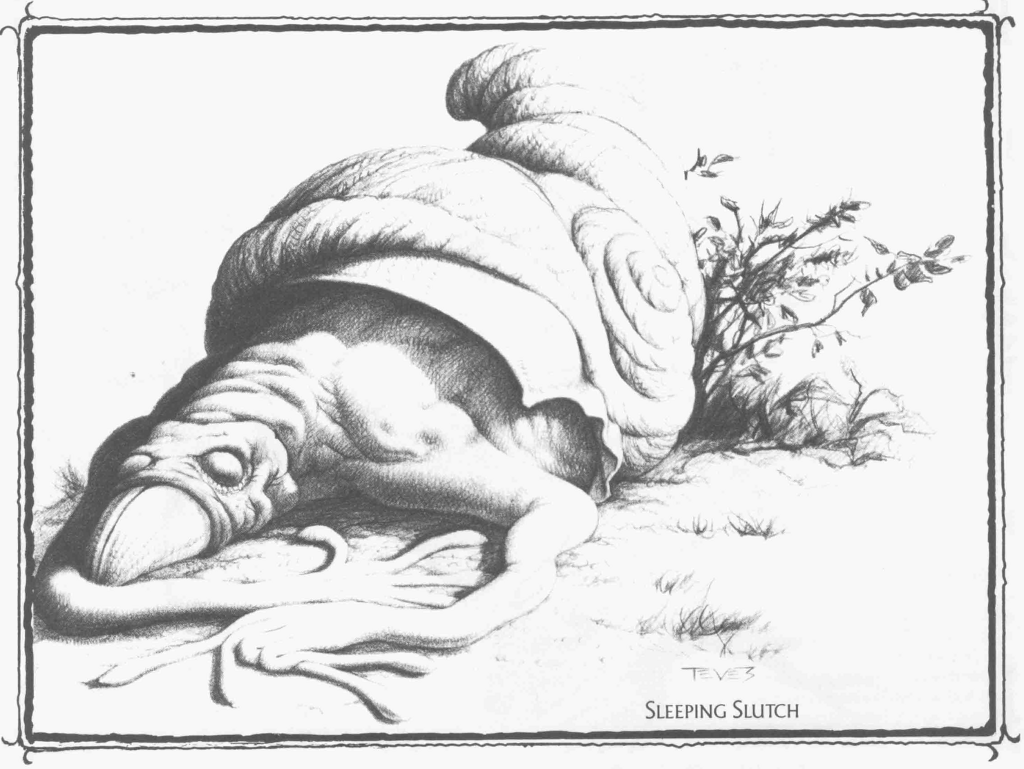
The slutch is a carapaced creature with a soft fleshy body. Slutch shells are treasured for their reflective properties. The underside of the slutch's arms contain hundreds of gas chambers which explodes when contacting an enemy.
TALMARON
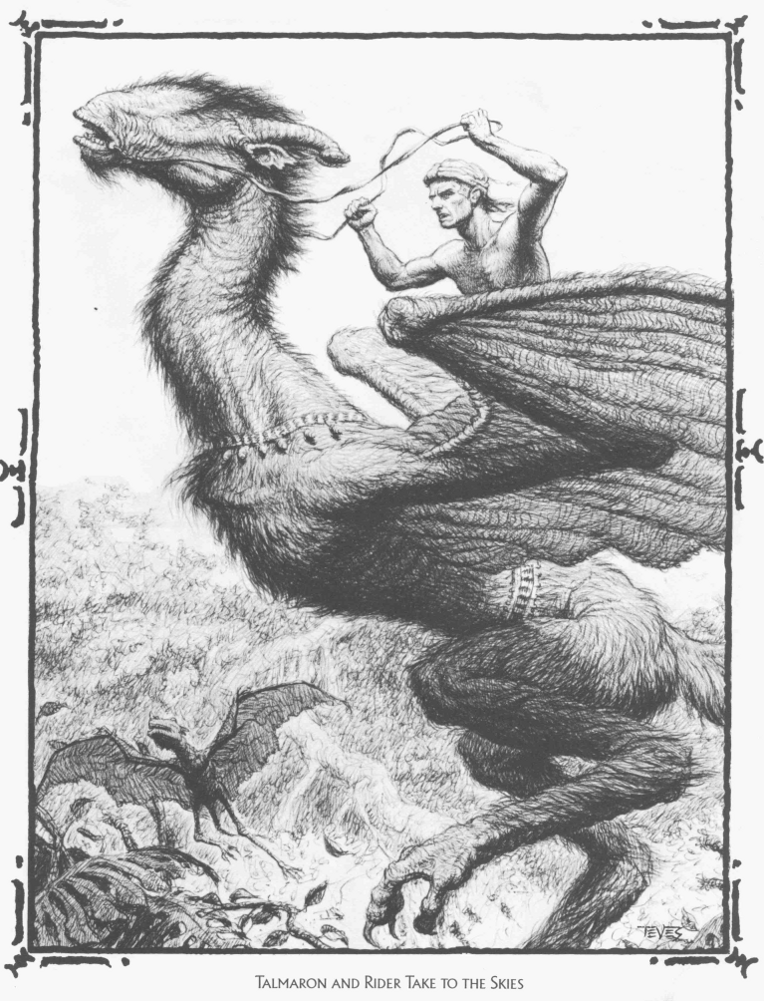
The weight of these creatures is more then their wings alone could support. However they are able to fly, and even take riders, due to their ability to support themselves on the Isho currents. They can ride this breeze for hours. They can be domesticated and can be trained as mounts.
THOMBO
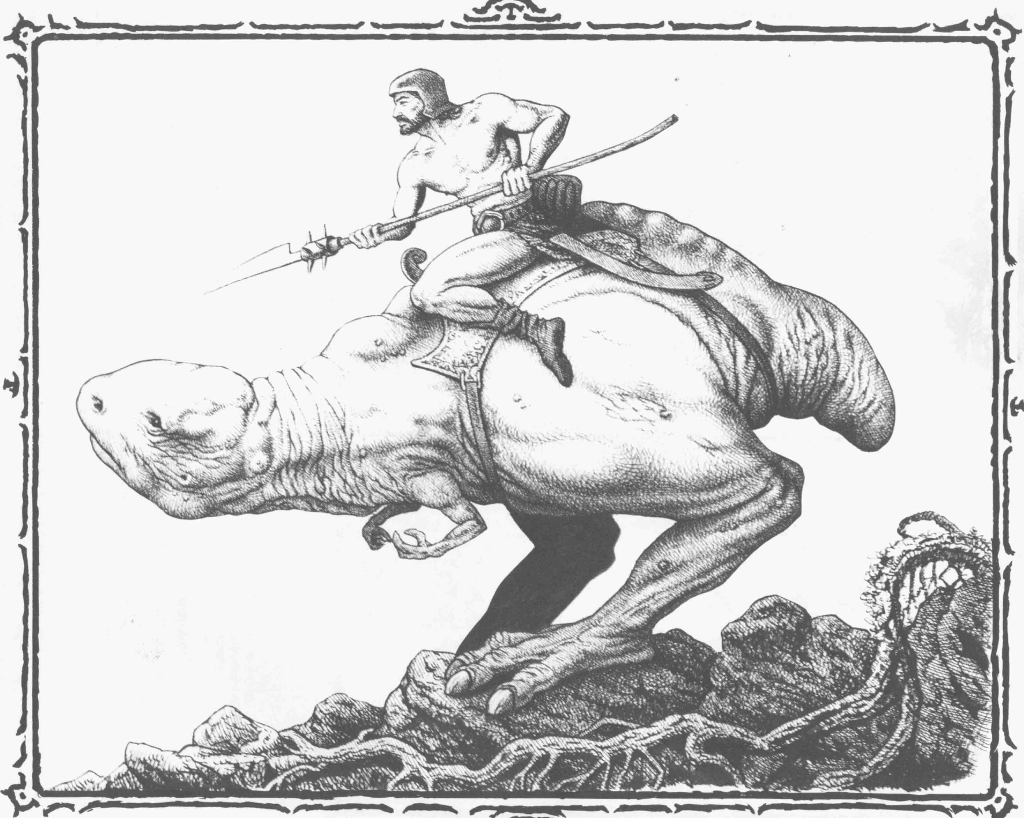
The book makes multiple points that they can't be used in combat, yet this guy seems to be...
Jorune natives with sightless eyes. They will bolt away from danger at first sight and they do not recognize their own size and strength. A thombo's kick is as unpredictable as it is painful. They have voracious appetites and need several hours a day to eat.
VODRA
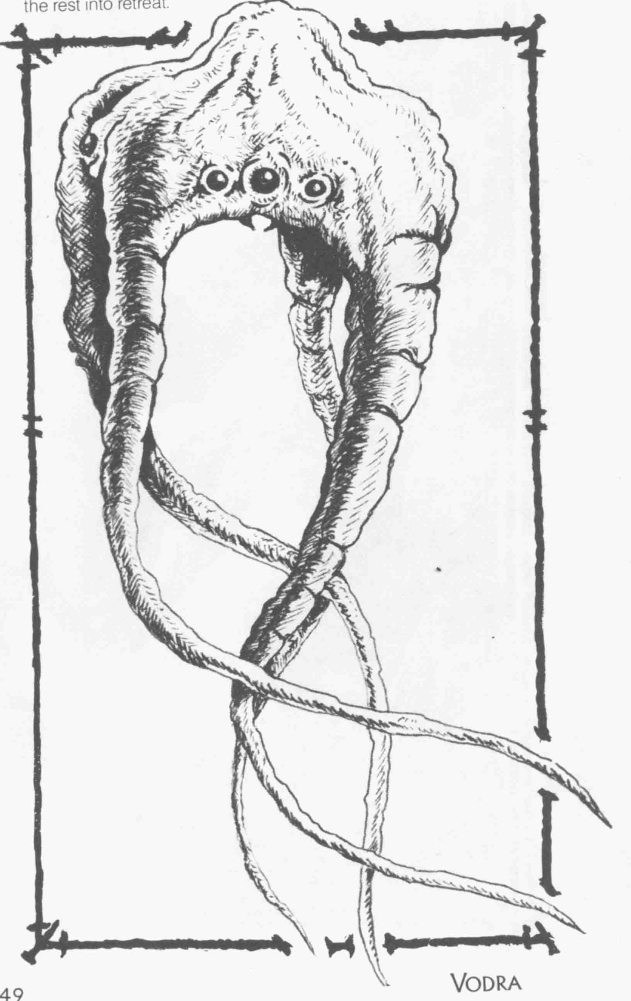
Hovering Jorune natives indigenous to the northern ice fields. They migrate south annually where they become a nuisance. They fly about 4 meters off the ground using Isho gliding. Deep within the bodies of vodra, crystals from their northern homes can be found (1d6 total). They use their tentacles to grab and snap at enemies which they then drag towards their beak-like undermouth. They can also use the frost bolt Dysha.
Chapter 5: Items
This chapter is basically a shoping list and most of the items have boring descriptions, availability rating and a price.
Of notes are crystals: these are color-coded and can usually allow their users to use them as Dysha creating devices with set amounts of charges. For example a blue crystal will allow to inflict 5 STA points of damage when activated. They are very rare and cost 3 gems.
Thailierian armor (made from Corondon hide) is the best non-Earth tec armor that money can buy. It's listed as very rare and costing 4 gemstars.
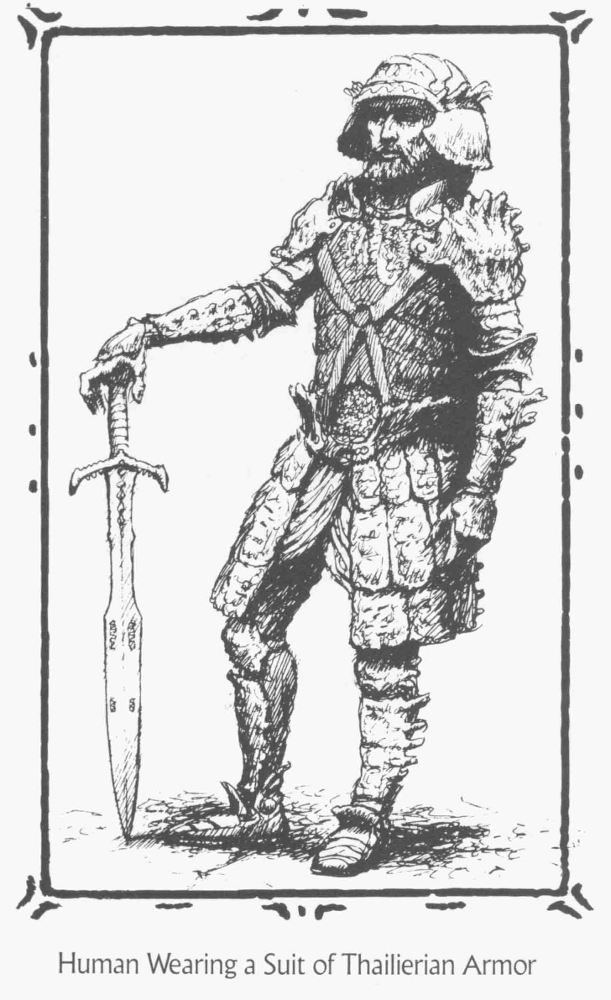
A human that is clearly not part of the 99%
You can also buy crystal armor which is leather embeded with shards of crystals. For every crystal (up to 50) the armor will have a chance to block 1 point of Isho. The chance of blocking is equal to the number of crystal in %. SO 50 crystals will block 50% of the time up to 50 Isho points. Every time one point is blocked, one crystal is destroyed in the process. Considering that it costs 2 gem stars and that any other armor will also block Dyshas (by simply being armor), this seems pointless.
Then we get some Earth-Tec devices. These range from gas filter and med kits to binoculars and comlinks. We also find the price of Earth-Tec weapons. They all come in pistol and rifle models, the only difference being the price and the augmented range for rifles.
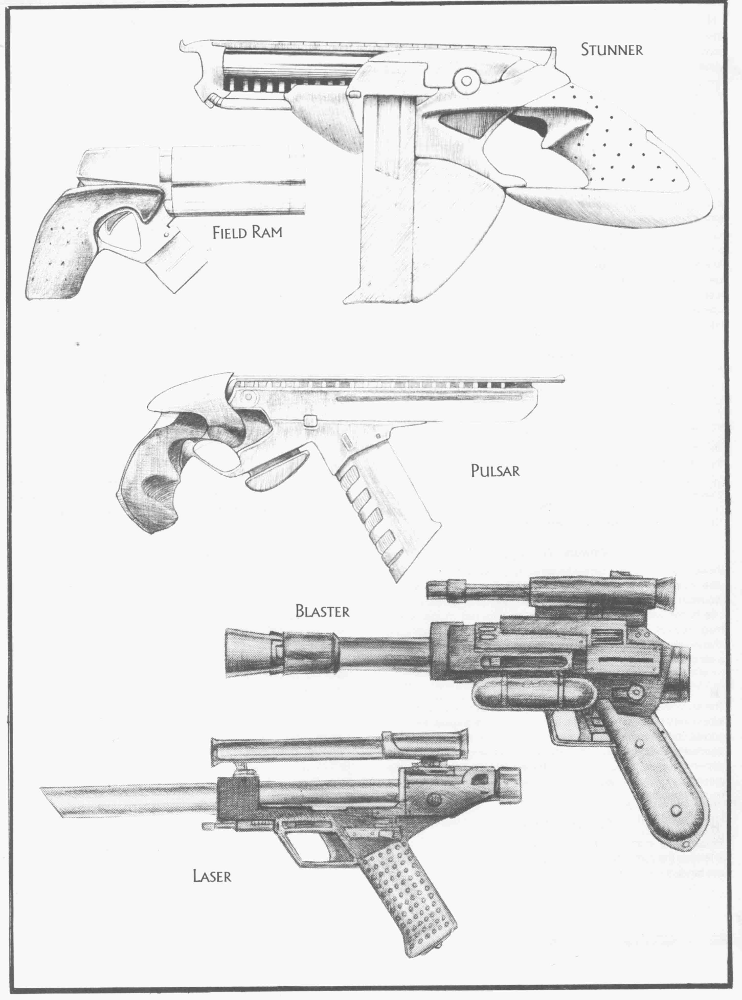
I'm pretty sure most of these are from Sci-fi movies and TV shows.
The next chapter is about places but there is no new info worth mentioning.
Chapter 7: Sholari Notes
This is basically 1 and ½ page of things that the designer didn't seem to know where to fit.
It starts by mentioning that we may have noticed the lack of hit points and that this was intentional to make combat more realistic. (I dunno, stamina points based on your CON attribute seem pretty much like hit points to me).
We then get a paragraph telling us that Boccord and Muadra are meant to be subtle races, not vicking and wizards respectively.
We learn that Tologra are an Iscin modified race of tigers and that they were his crowning achievement. They are powerful, cunning, intelligent and restrained
 They are not shown in the 1st edition, we're told, because their lands are too far away to the east. I found a picture of them on the net.
They are not shown in the 1st edition, we're told, because their lands are too far away to the east. I found a picture of them on the net.
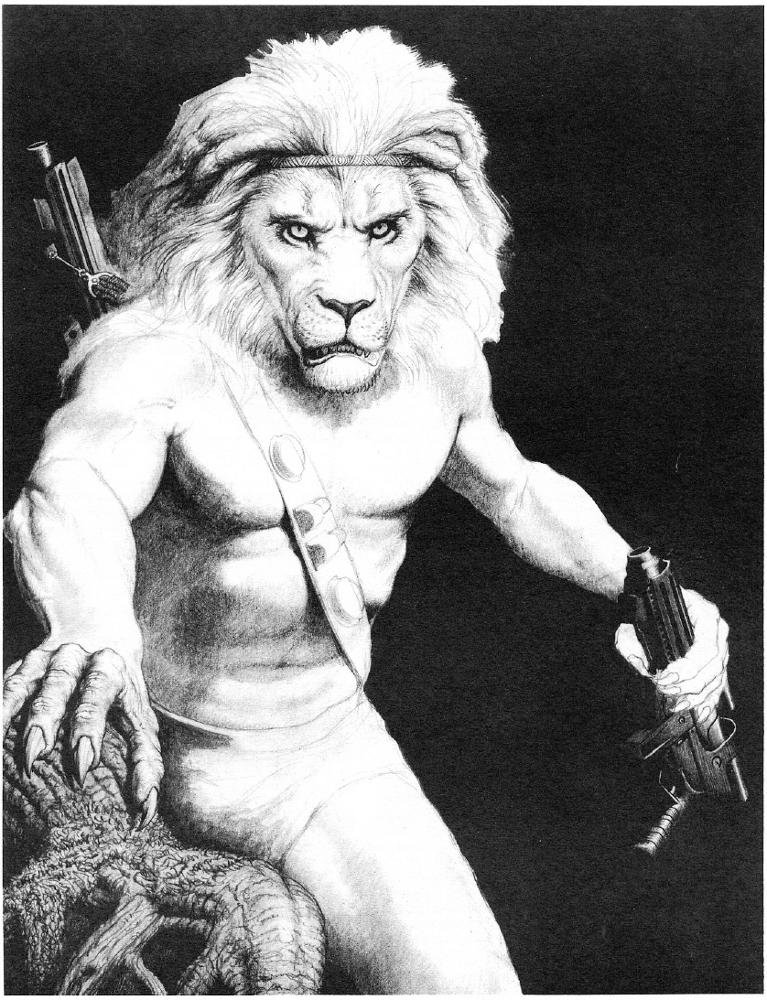
 That's not even a tiger.
That's not even a tiger.
Then, as a throwaway line, we learn that, yes, there are quite a few non-native intelligent races on Jorune (these include Corastin, Ramian, Croid, Thriddle, Cleash and Scarmis). Traces of a civilization of enormous bipeds along the Ramian lne have been known since the early colonization. These were known as the “Lamorri” and they obviously evolved elsewhere.
We are also told, again, that Earth-Tec is strictly regulated.
We get a “hilarious” joke that game designers are always at ½ Isho because they never get a good night's sleep...
We're told that there is to be no interbreeding between the human races (nothing about Iscin races though)
The last paragraph of all things is a description of a new set of Earth-Tec armor that is nowhere in the items section. E.R.P armor (Energy Reflective Plastic).
That's it for the Sholari Guide and all the rules and setting for the game. It's a bit of a mess really. I had to backtrack a few times to understand some concepts and their homebrew terminology doesn't help. There is a LOT of repeated material across all three rule books as well as a lot of repeated art. The books have quite a few typos as well.
With a little bit of tweaking it might make for an interesting setting to play in. One thing's for sure, I would try to give more motivation to the players than “you all desperately want to become citizens for no well explained reason.”
Perhaps the adventure provided with the box set will help set the tone of the game for a new group.
Next time: Adventure Time
The Skyrealm Kolovisondra
Original SA post
Adventure Module: The Skyrealm Kolovisondra
This is a 15 page booklet (4 of which are full-page art) that is meant to be an introductory adventure set on one of the many skyrealms that float above Jorune.
The module starts with a section with brief explanations on skyrealm formation. They can happen when molten crystals seep to the surface and detach a section of land (type I), by slow plate movement (type II) or by volcanic eruption(type III). Kolovisondra is a type I skyrealm. It's also one of the few ones that moves. Apparently some skyrealms follow the flow of underground molten cystals – Kolovisondra is heading east. Its ultimate destination, unknown.
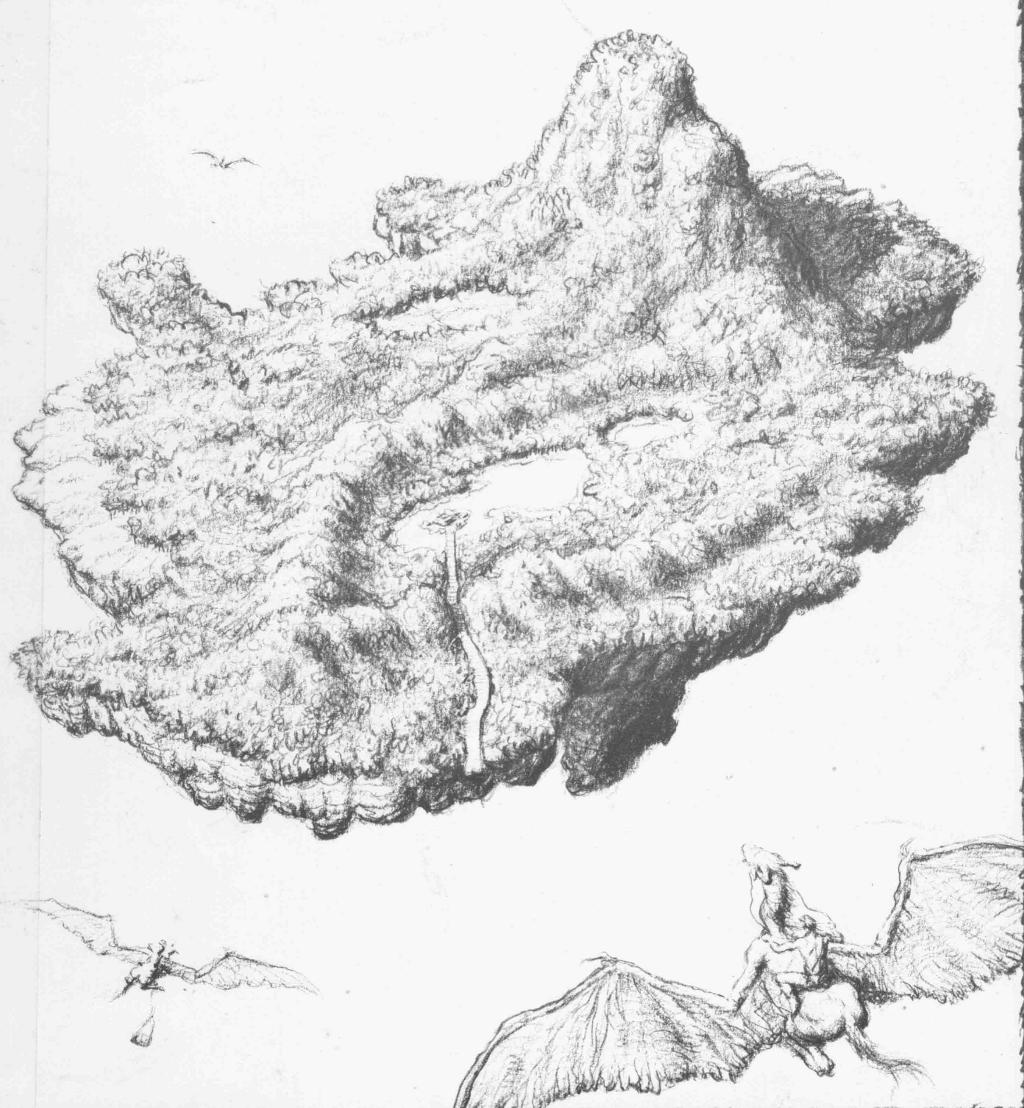
Kolovisondra. For scale: it's about 1 mile wide by 2 miles long
Section 2: beginning the campaign
The players are hanging out in a tavern (no, really, this is how it starts). It's empty except for the barkeep. A while later 2 humans walk in and, with a successful listen check, the PCs learn that they just came to an agreement. The humans approach the PCs and, in hushed tones, ask them if they want to make some extra yules (cash).
They mention that a week ago one of them found a skyrealm. He went up there on Talmarons (those flying mounts) with the rest of his party and found that the skyrealm was full of shirm-eh (the healing herb prized by Ramians – also very, very illegal to trade or possess). He came back to Ardoth to find his friend and hire some guards (the PCs). He will give them 2 gems each and shares of the shirm-eh. Oh, and by the way, the skyrealm is lethal to Jorune-based lifeform. His Talmaron died just after bringing him back. So don't bring your pet Tarro or anything.
He tells the PCs to go find them ship passage to the East Trinnu Jungle Lands, above where the skyrealm is currently moving. Of course the PCs have to accept (or, the book tells us, it will be very short campaign). Never mind the fact that they might not want to be involved in illegal trade that benefits one of the main enemies of the setting or that they might decide to turn in the two humans and call it a day. No, the PCs all jump in at the chance for some sweet, sweet smuggling of illegal drugs.
Section 3: traveling to Anasan
There are 2 choices to travel to Anasan (a city in the jungle). For one, the PCs can travel via warp. This would require them to have a map of warps from here to Anasan (warp maps being exceedingly rare we found in the Sholari Guide) and also to know someone powerful enough to open a stable warp. The book mentions that they can find a willing Shanta for 2 gems per person – even though the books previously established that Shantas were 1) rare and 2) not really interested in dealing with non-Shantas for anything but Shantic artifacts.
The other option is to travel by sea. The module then provides the following options for the PCs to choose from. No matter which one they pick, they end up in the right place withing a few days of the other options.
Option 1: The Geshan. This boat is mostly Woffen and is luxurious. Cost of 20 gemlinks/passengers. The 2 humans won't like the price but they'll pay.
Option 2: The Trenson. A produce freighter available for 3 gemlinks/per. The PC's have a chance (3d6 under CON or else) to catch disease while on this boat.
Option 3: The Kurlew. Will hire temporary ship hands for 2 gemlinks/per. (Why do they have to pay if they work for it?). The captain happens to be a smuggler of shirm-eh. If the player so much as mention the skyrealm and its contents, they're in for trouble.
Option 4: The Thobren. A Bronth run ship. Fast and clean. The PCs will even pick up a whole rank of Bronth Etiquette if they pick this one. Price of 50 gemules/per. The cheapest option by far. Why they wouldn't choose this one is beyond me.
OCEAN ENCOUNTERS
The ocean travel will take from 12-15 days depending on the ship. The book suggests to throw a few encounters to break up the monotony. One is with Salu (Human offshoots, we have a picture below). The Salu will board the ship from a Salu chausis and be interested in the destination and cargo. This is meant as an interesting rather than bloody encounter. Although why would a captain allow another ship to board his without cause, I don't know.
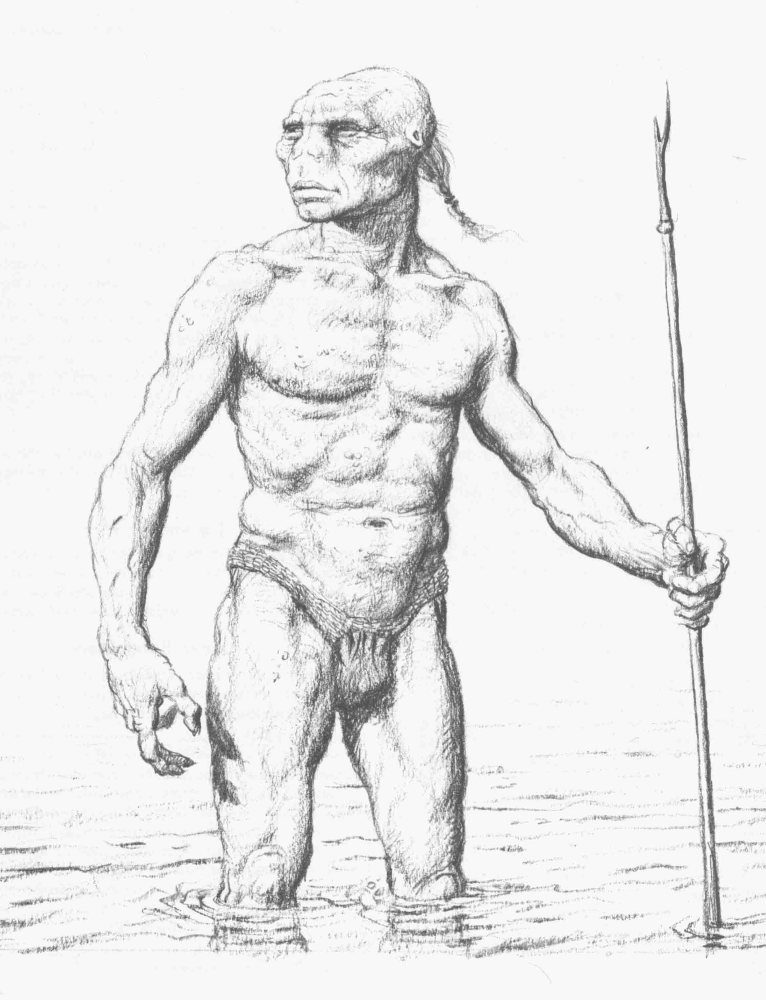
A Salu with authentic banana hammock.
A big storm that throws aggressive sea life on the deck.
Vodras (those tentacles floating things from last update). The more vodra, the more adventure, we're told.
Section 4: From Anasan to the skyrealm
There's a short river boat ride to be had to go as close to the skyrealm as possible, then it's a matter of getting up to it.
Kolovisondra, like most skyrealms, is floating about 1km up. It's also moving at about 6 miles/day. Again, a few options are given:
Option 1: Talmaron. The PCs could ride the Talmarons up but chances are they'd die up there since the skyrealm makes Jorune life sick.
Option 2: Warps. Again with the super rare warps.
Option 3: Crystal air ship. Some clever people have figured out a way to build ships that float on the Isho currents (the bottom deck is lined with crystals). The PCs might hire one for a price (no price actually given).
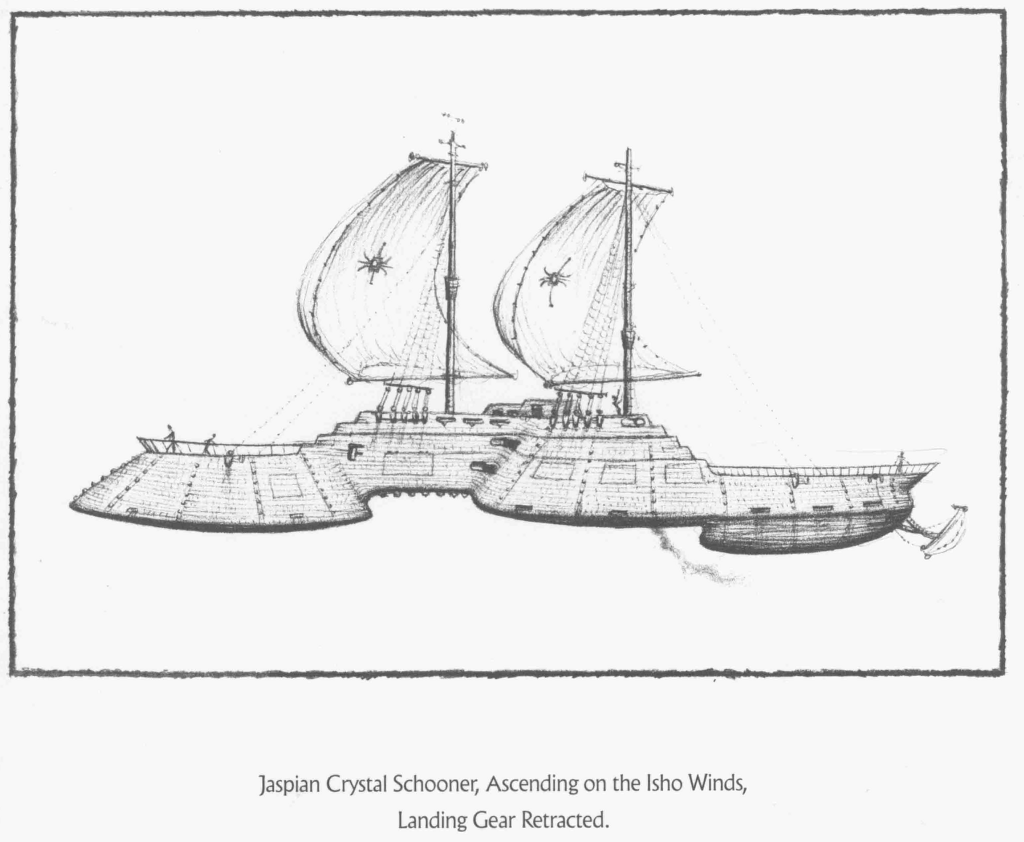
An air ship
Option 4: Nope, that's it. Talmarons, ships or warps. Get up and maybe not get down. Talmarons very well might die and warps only last for a few minutes, maybe an hour if the one creating it is very powerful. Only the ship option seems to make sense.
Section 5: The journal of the Kolovisondra skyrealm
Here we learn that for thousands of years, Kolovisondra (which means “protector of the valley” to the tribes of the jungle) was nestled against a mountain range and Shantas built a bridge to it and an observatory on it. A while back, volcanic tremors freed the skyrealm from its perch and it's been floating ever since.
Two days after the human left for Ardoth to find his friend the skyrealm passed within sight range of some Ramian pirates that sent a scouting party on it. They returned with news of shirm-eh and 25 Ramians remain on it to scout it out. Their ship went back north to get a companion vessel to transport the shirm-eh. Since the scout's Talmarons died, they've been weaving ropes to climb down (remember: this thing is 1 kilometer up ). That's some long-ass rope.
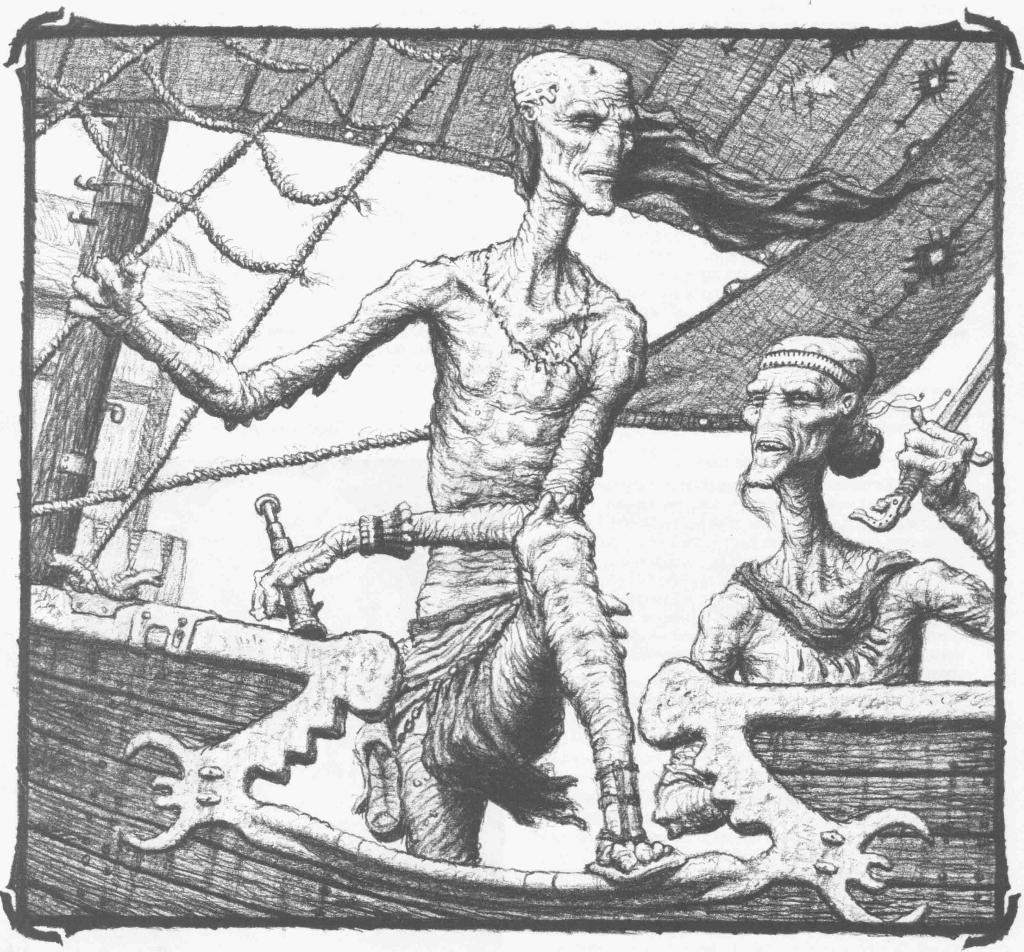
Ramians. Pirates and rope-makers
We then get a day-by-day recounting of events happening on the skyrealm. It's worth mentioning that there are a bunch of events that will happen well after the PCs land on the skyrealm. Apparently the deisgners didn't feel that the PCs could in any way affect the outcome of their little scenario...
I'll list some important events:
Day 1: skyrealm detaches from mountain and breaks bridge leading to it.
Day 5: one of the humans that hired the PCs first travels to skyrealm with some buddies. He then leaves them there to go get more help in Ardoth.
Day 7: Ramian pirates find the skyrealm and send 25 of their own on it.
Day 28: Rumors of a skyrealm reach the ears of the leaders of the realm of Khodre. They send a ship to take control of it.
Day 30: The day the PCs make their way to the skyrealm.
Day 35: 10 Ramian a day (from the other ship) start to board the skyrealm (via Talmaron presumably)
Day 40: All Ramian Talmarons are dead.
Day 49: Kolovisondra impacts another mountain range and will remain jammed there for 2 days. This is the only chance to get off unless the PCs still have access to an air ship.
Day 53: the skyrealm floats over the sea and more Ramians board it by climbing up 1km-long ropes, we're told.
Day 55: The airships from Khodre arrive and clash with the Ramians.
Day 60: Burdoth learn of the skyrealm and is outraged that Khodre did not inform them. They send their own force.
Day 61: Khodre forces retreat and claim that all the shirm-eh collected has been destroyed.
Day 73: Burdoth forces arrive but storms prevent boarding.
Day 74: The huge mass of the skyrealm affects local warps and it dissapears into an enormous skyrealm-sized warp, never to be seen again. Hope the PCs were off!
Section 6: What is on the skyrealm
Ramians. From my count there will be at least 75 Ramians on it by day 40, possible more to come (via rope) later.
Ramians also have Tarch slaves with them. This is the first we learn of Trarch. They are apparently a human offshoot (another one) and are not very intelligent. They're big and dumb and make good fighters.
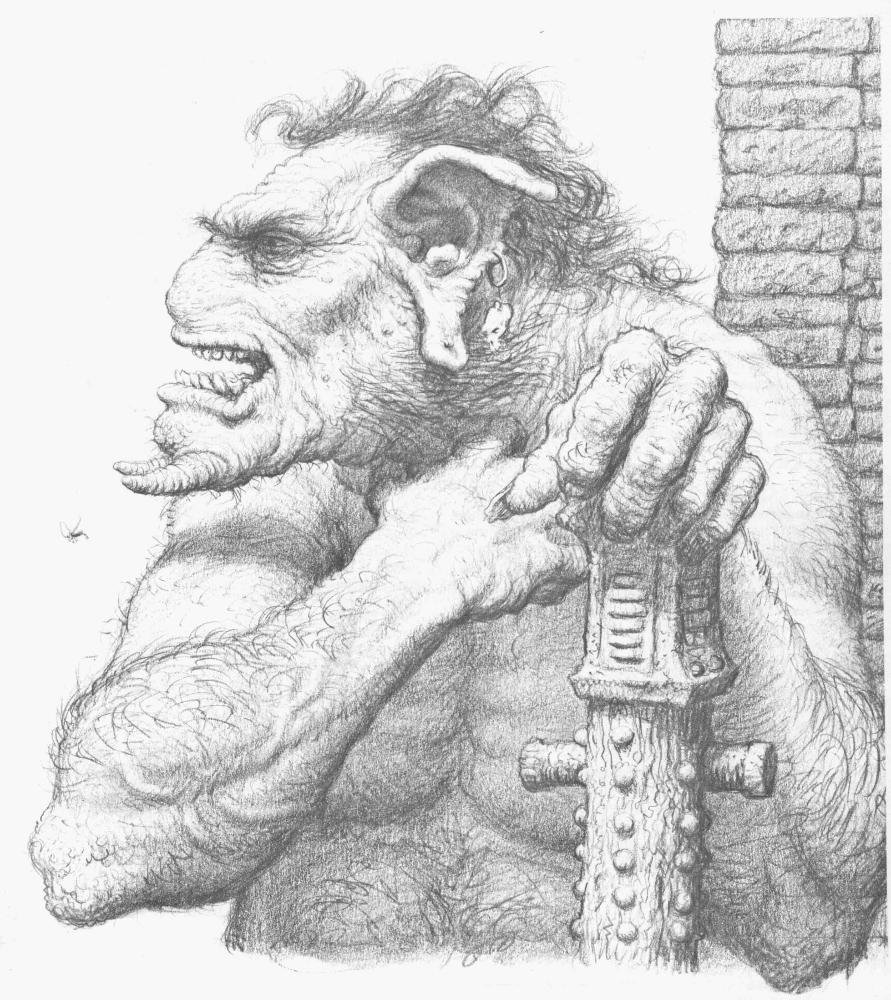
A Trarch. This thing evolved from humans within less than 3500 years.
Forces from Khodre. We never learn how many board the skyrealm but we know that by day 55, they are there.
A bunch of shirm-eh for the picking.
Marker stones. Of Shantic origin, we're told that the players will never find what they are for no matter how long they spend on them.
A freaking Dhar Corondon. This 1 by 2 miles floating island is starting to feel corwded.
The Shantic observatory. This is the main structure of interest. It rests on a small island in the middle of the one lake. If explored, the PC will find a chamber with a carved stone sphere on a pillar. Crystals are embedded in the sphere which is meant to represent the surface of Shal, one of Jorune's moons.
If a crystal is touched, the PC will take the equivalent of a lighting Dysha's damage. If activated by a Muadra's Isho, seven large pillars will rise from the lake's floor to a height of 30 feet. At which point the skyrealm will lose 30 meters of altitude in 10 seconds (they still alternate between feet and meters when describing things). It will regain it's original altitude in a few hours.
Unknown to the players, the altar is a giant cle-estha (an amplifier of Tra-Sense). This was a place to observe the heavens and analyze the flow of Isho.
It's mentioned that those who touched the crystals and got zapped will feel dizzy in a few days and the only cure that will work is visiting a Shanta. After being cured, their color attribute will go up 1 point.
And that's it for the intro adventure provided with the box set. Much of the module is left to the GM's interpretation in how events unfold (besides those that are pre-set to happen). We're left with maybe a cool place to explore but I would hardly call this an adventure module. What's also puzzling is that the designers chose this of all places to introduce two seemingly major elements of the setting: crystal air ships and a new human offshoot race, the Trarch.
It feels much like the rest of the game; unfinished, hastily cobbled together and all over the place.
I hope that the subsequent editions did a better job to introduce the setting and try to present it in a more coherent manner. I kind of doubt it though.
Next time: Nothing, we're done with the 1st edition box set